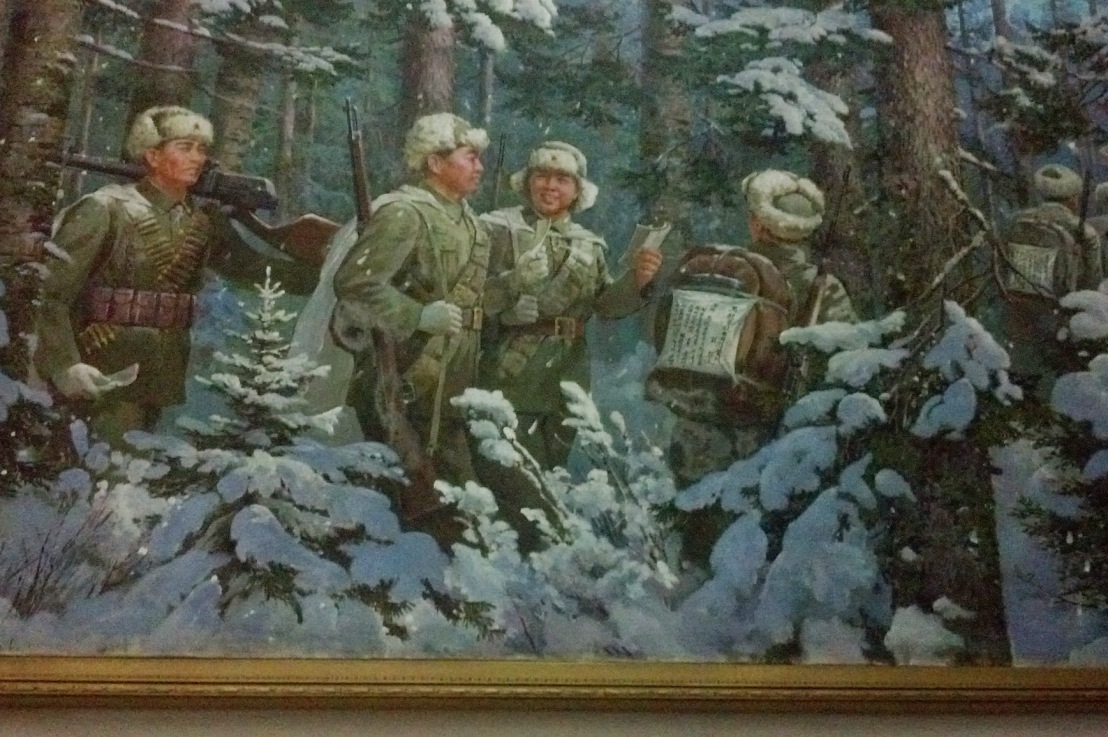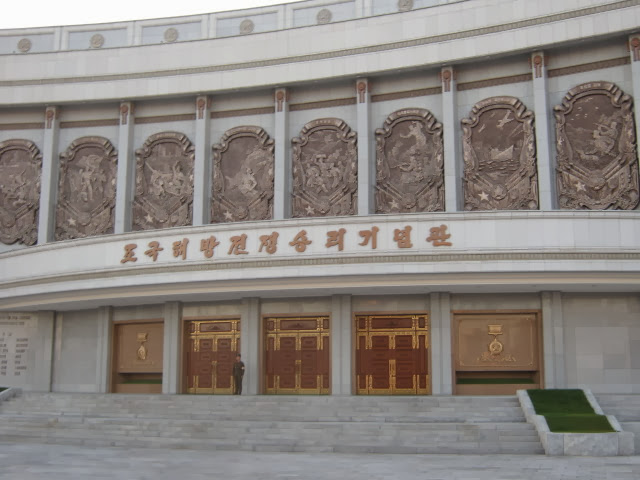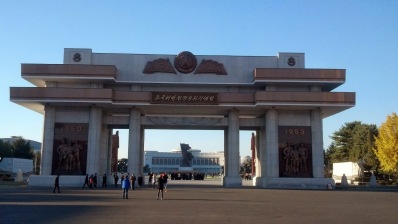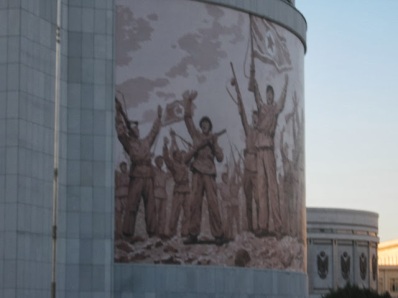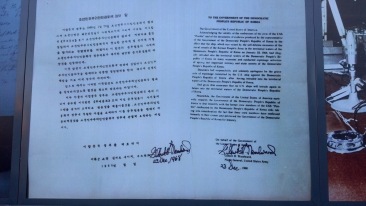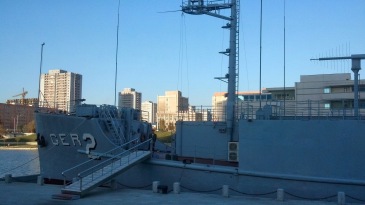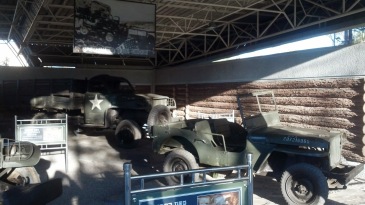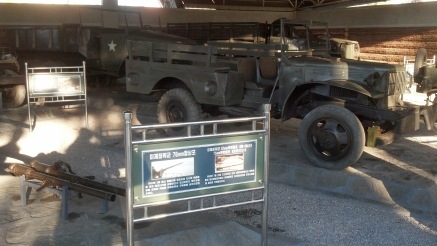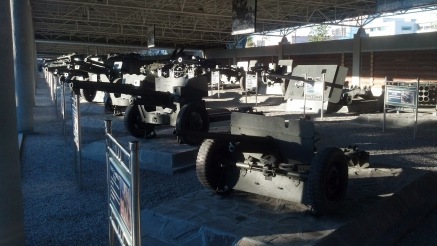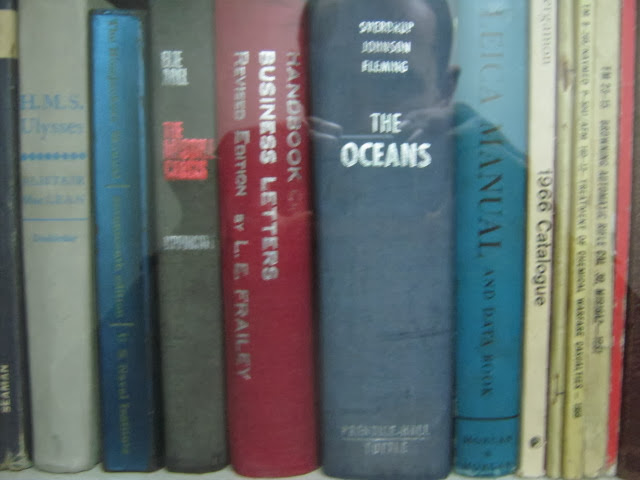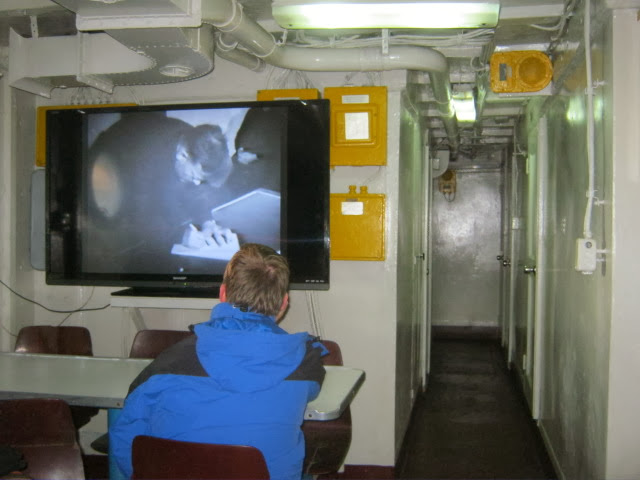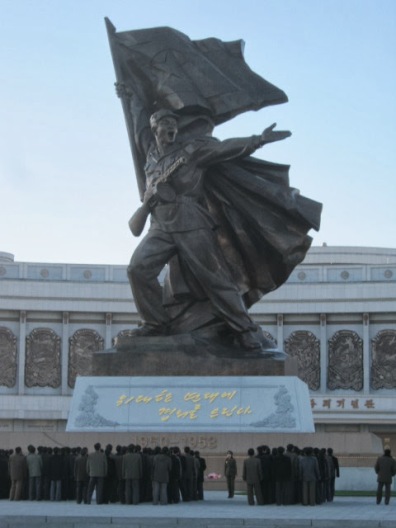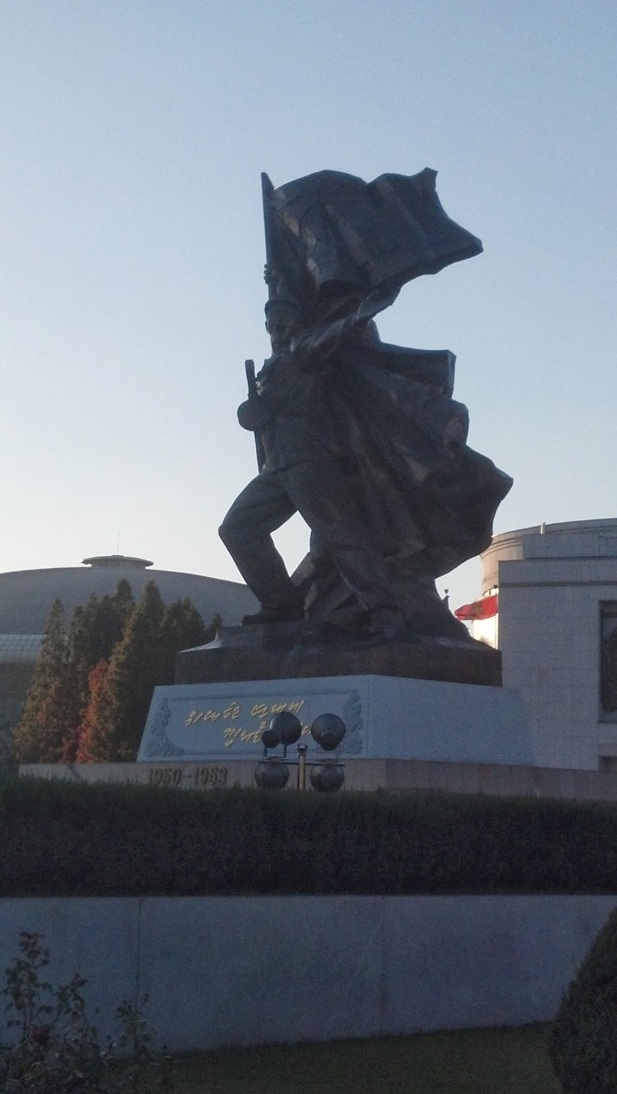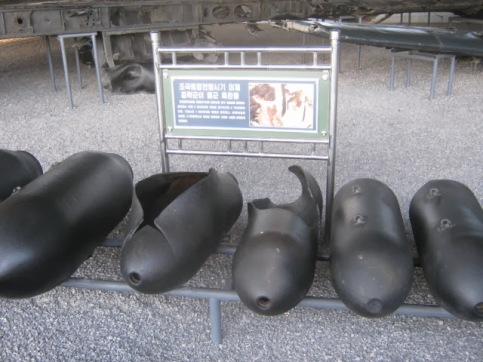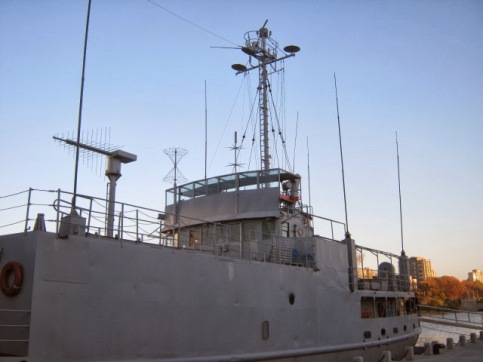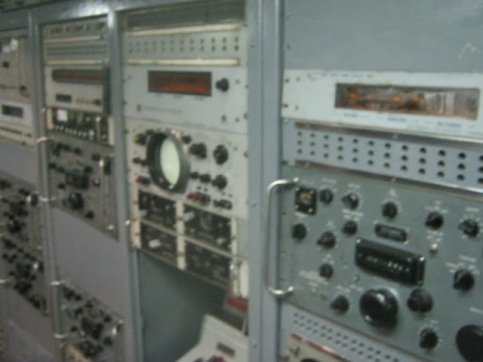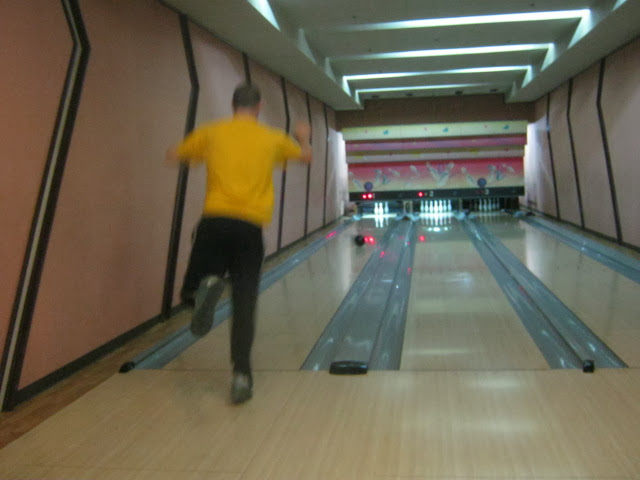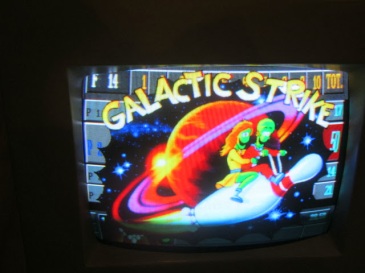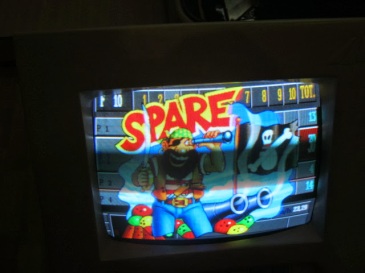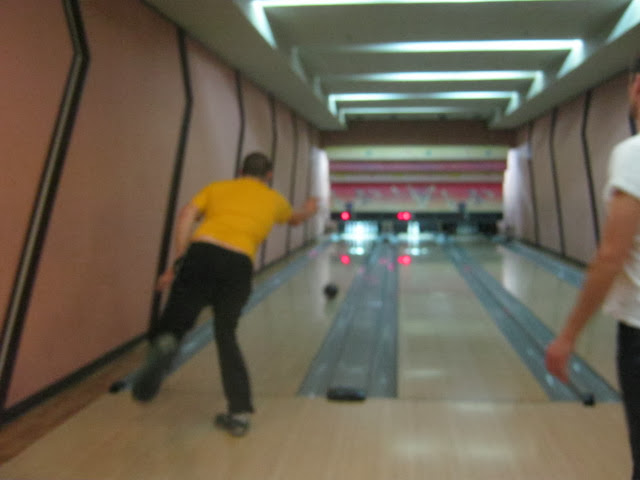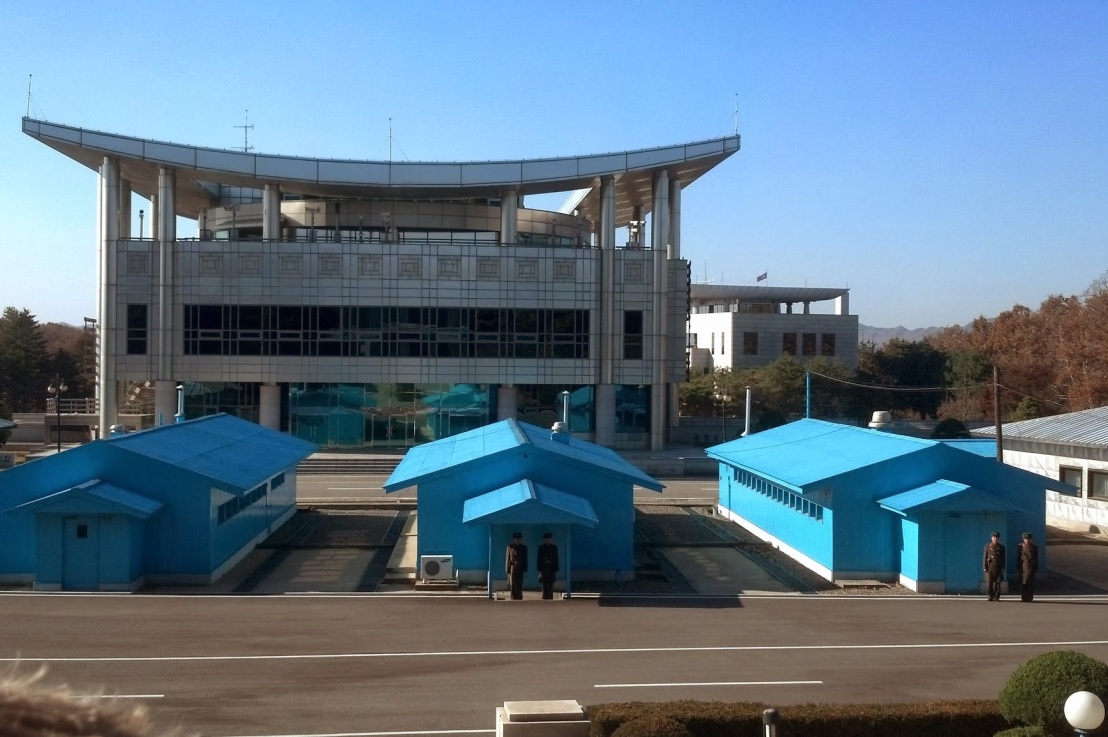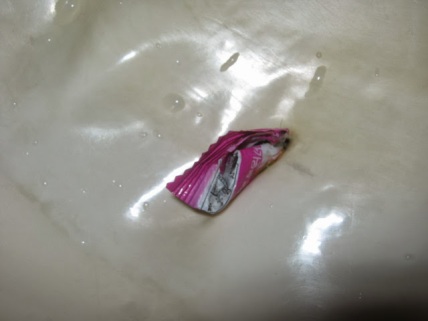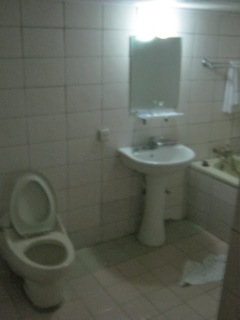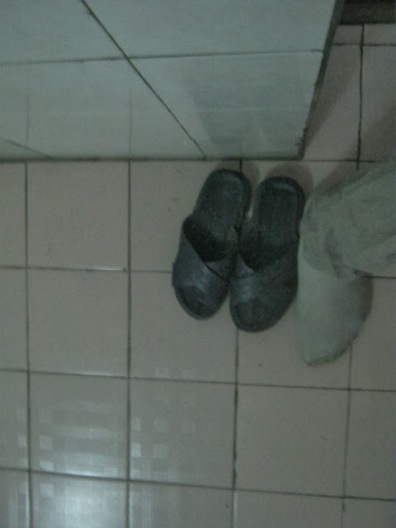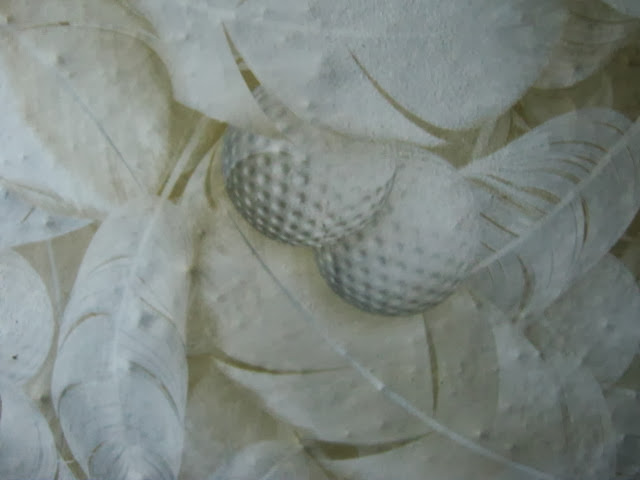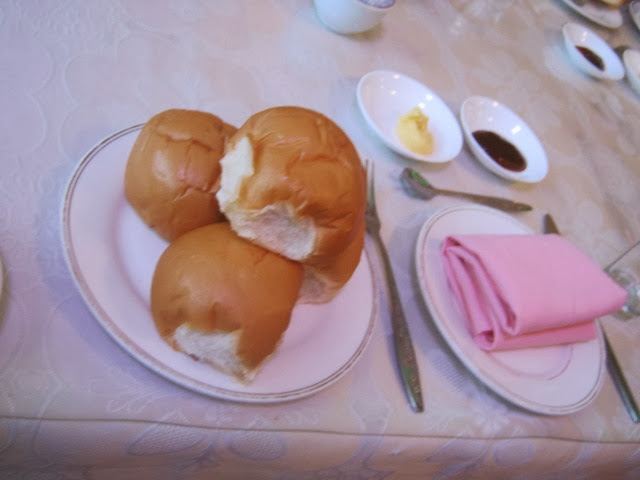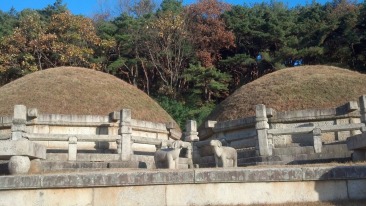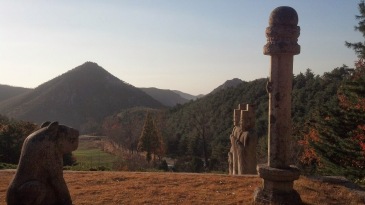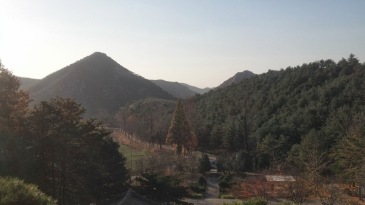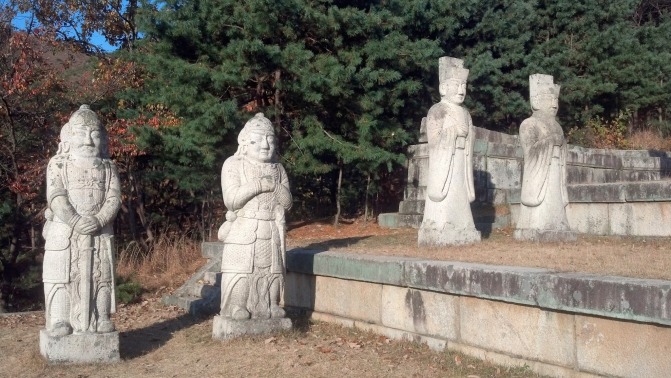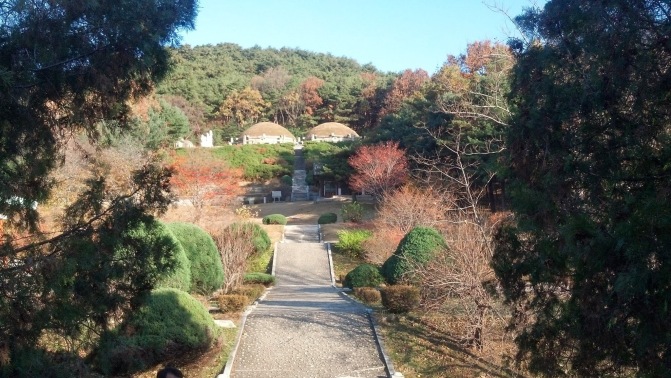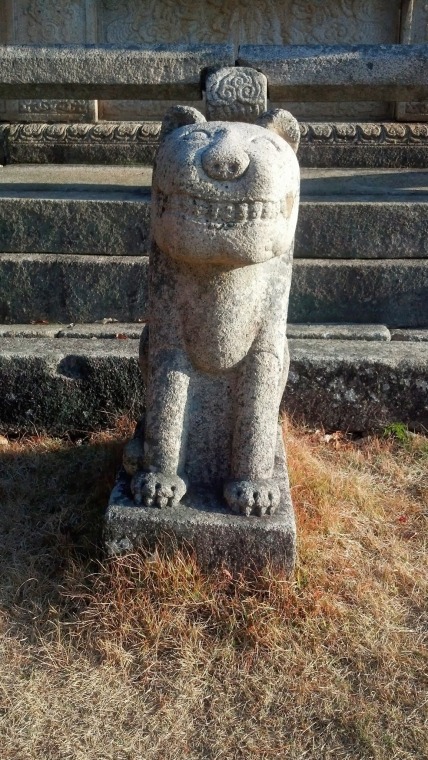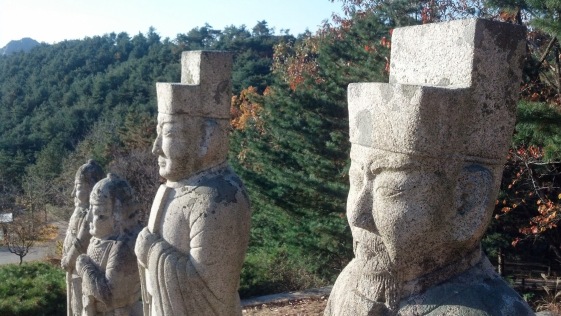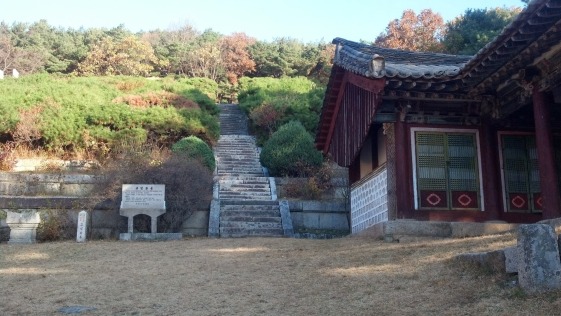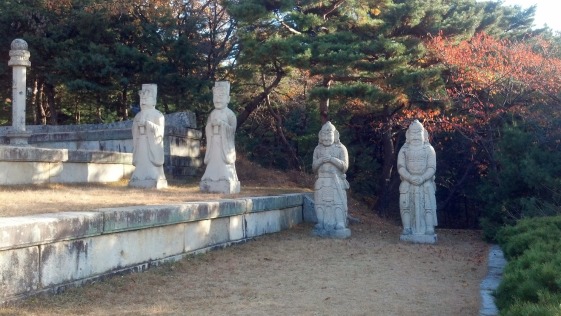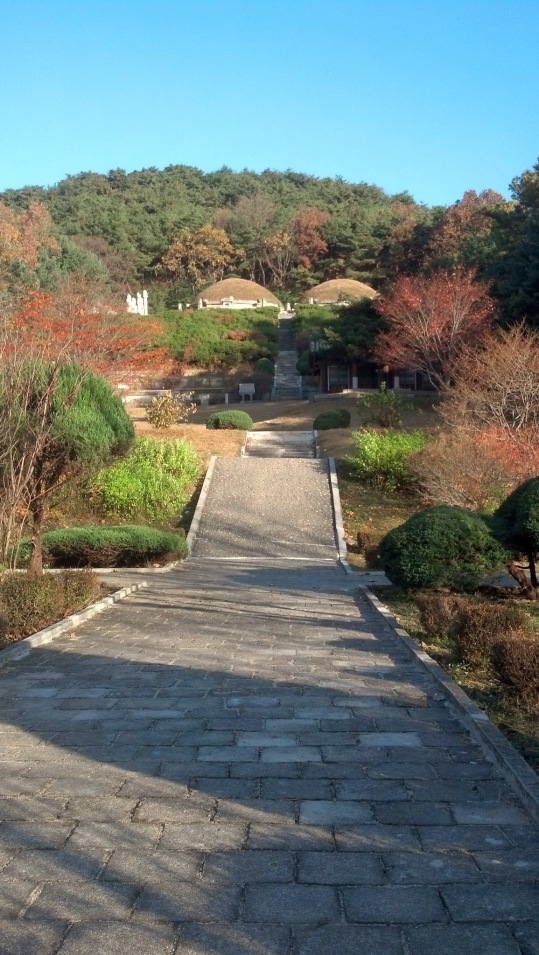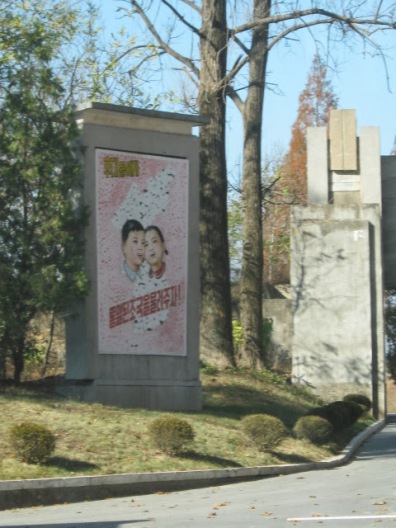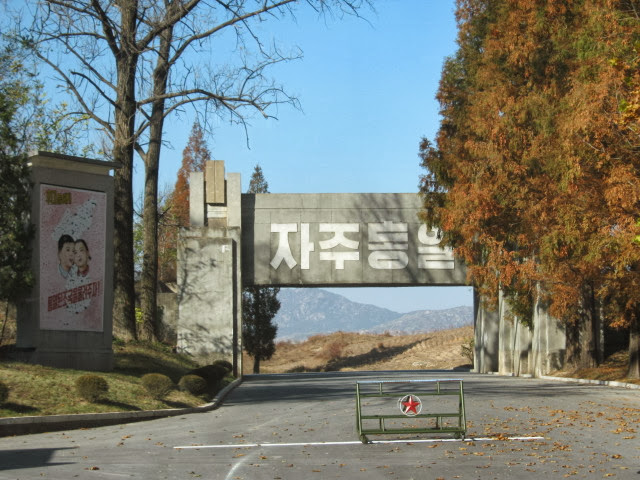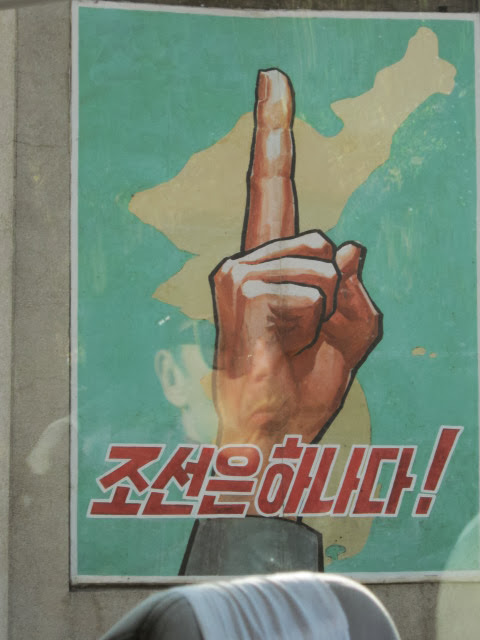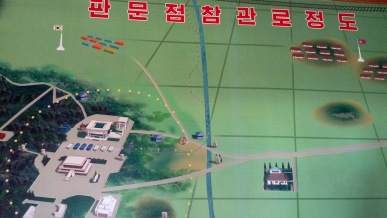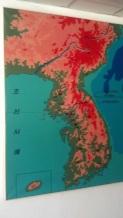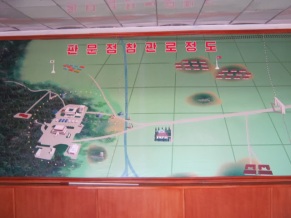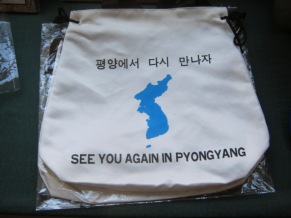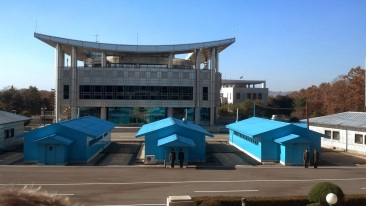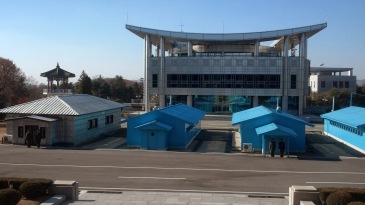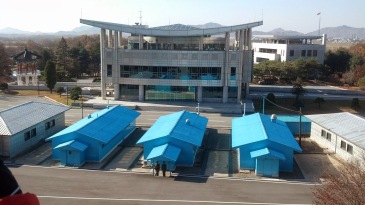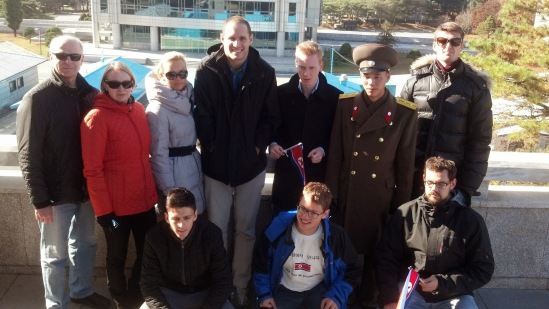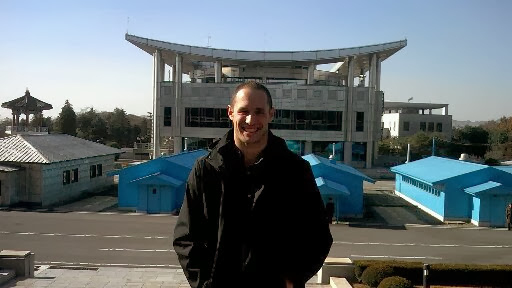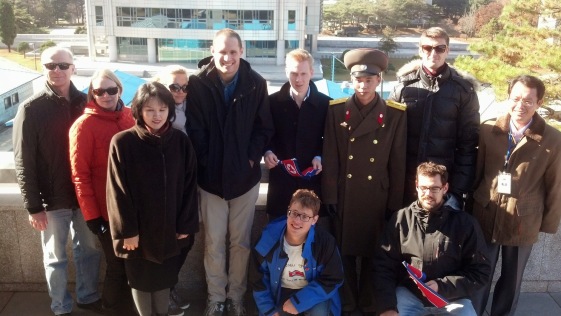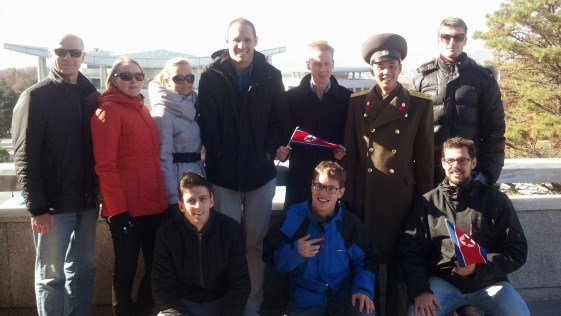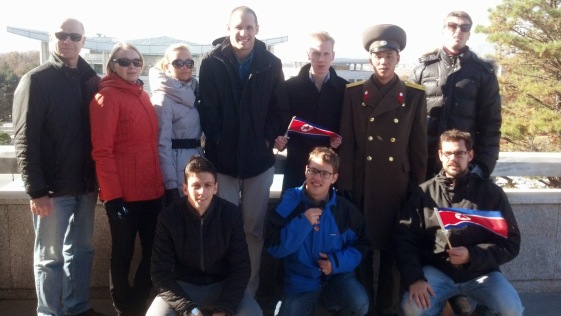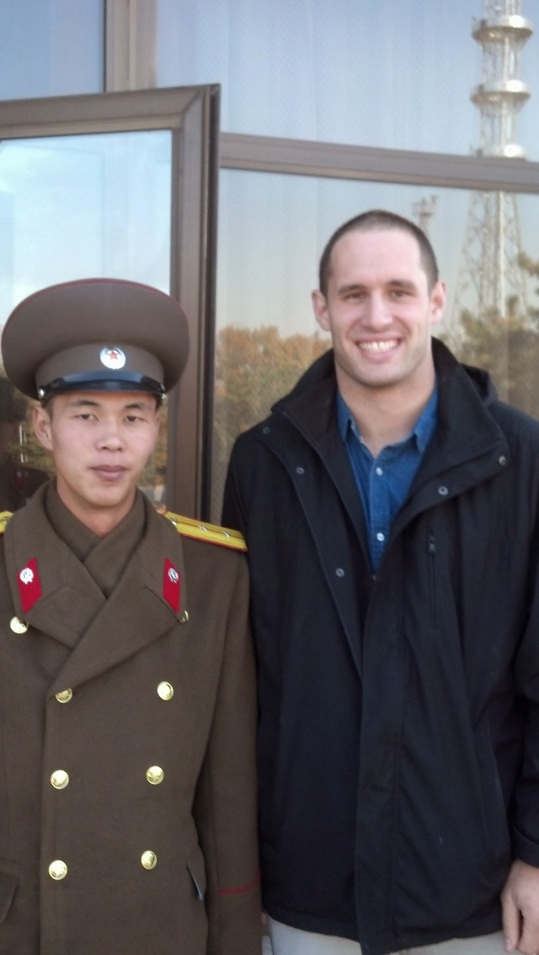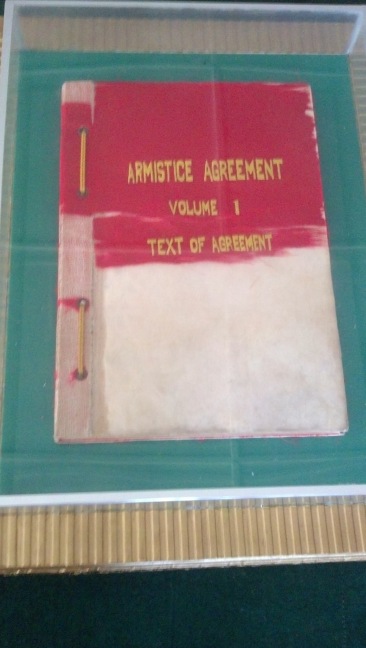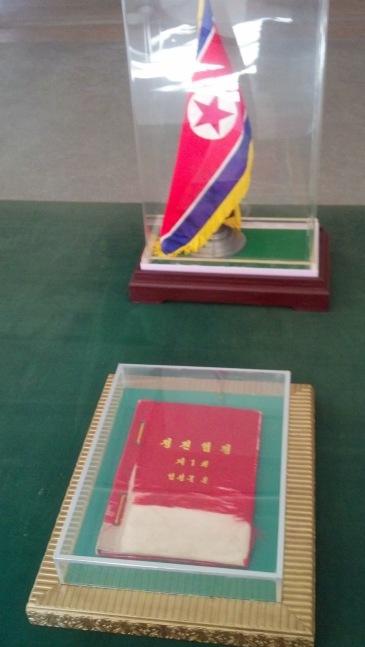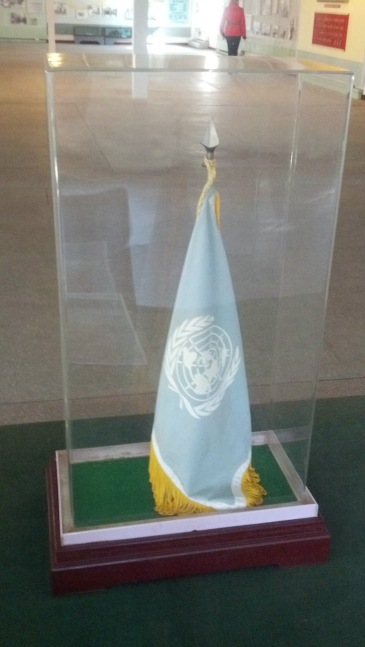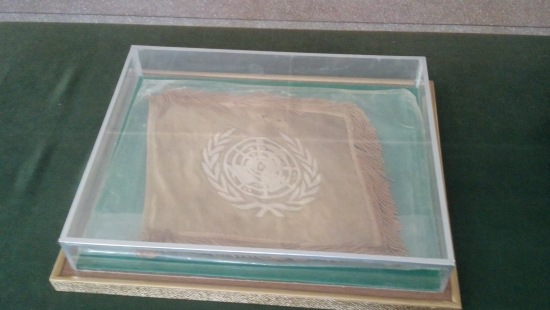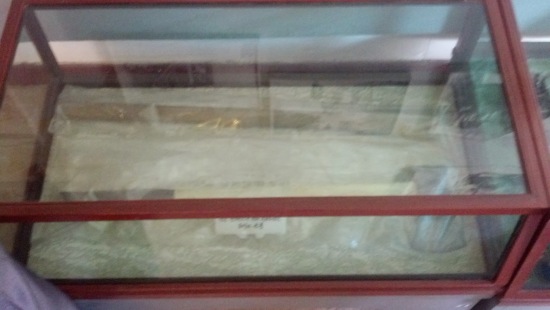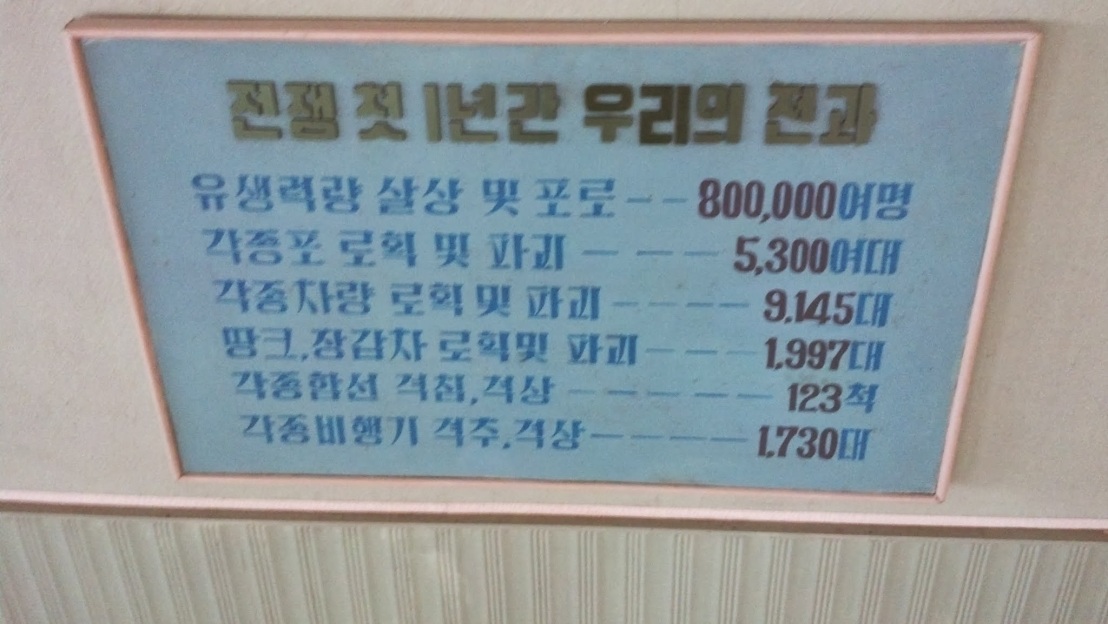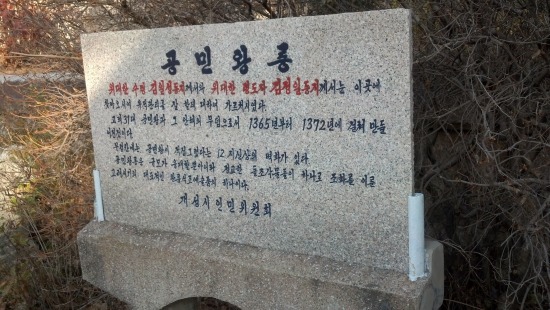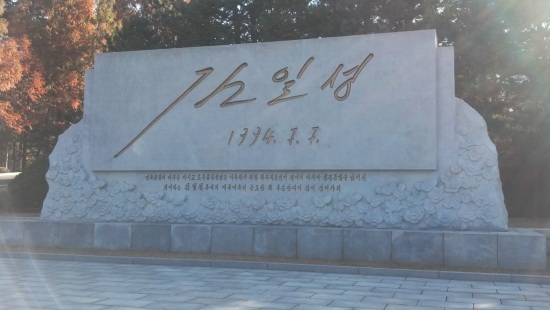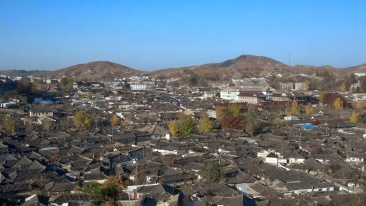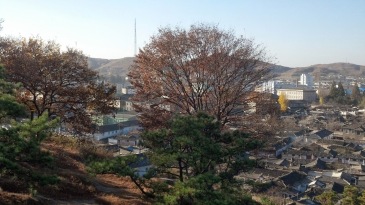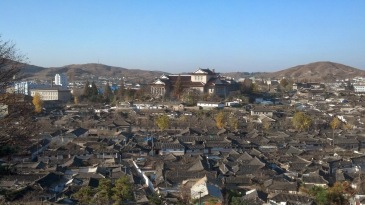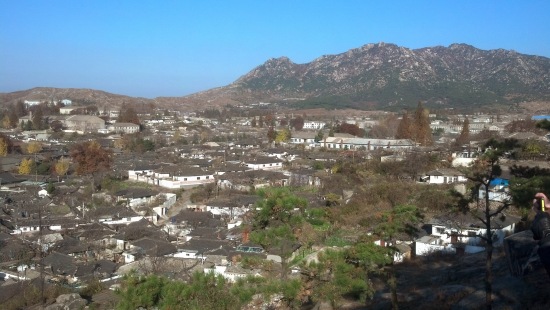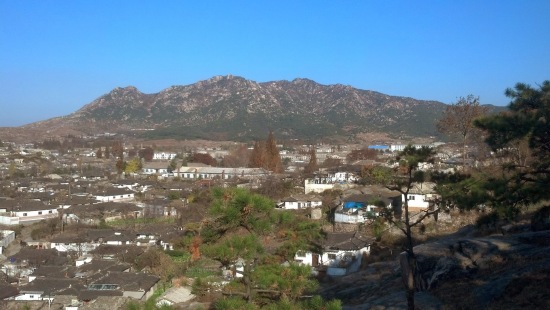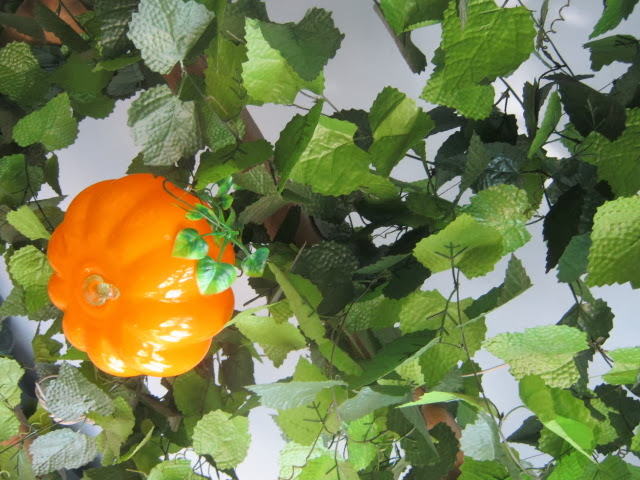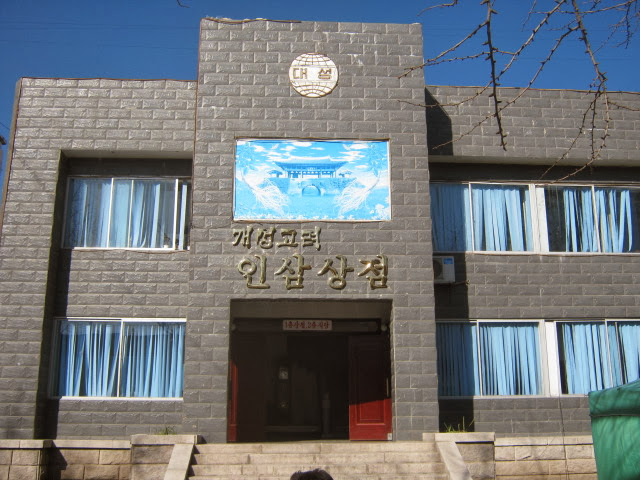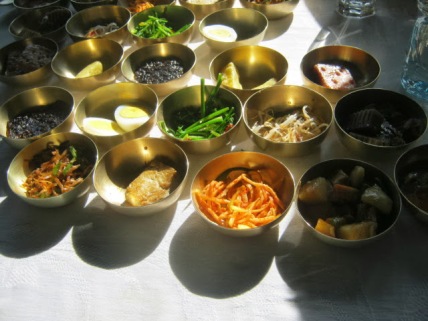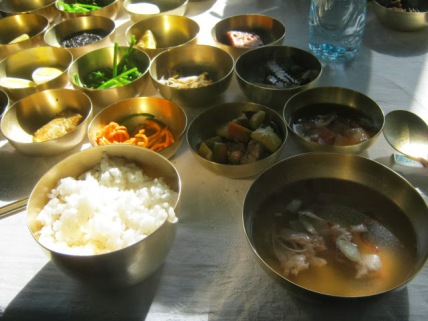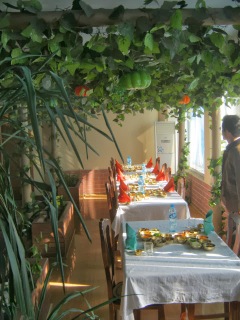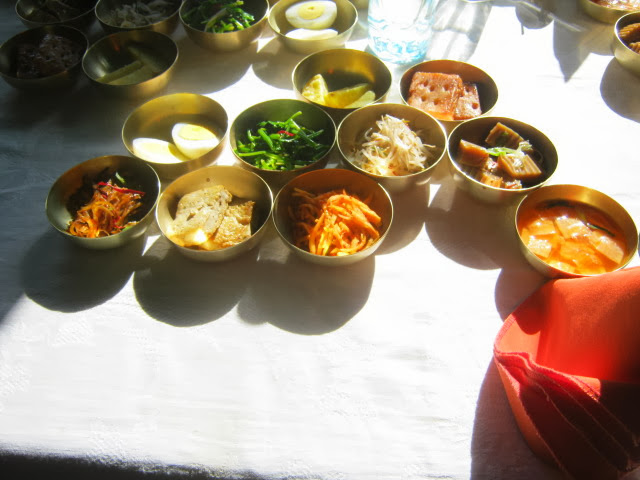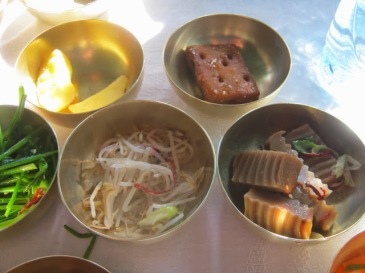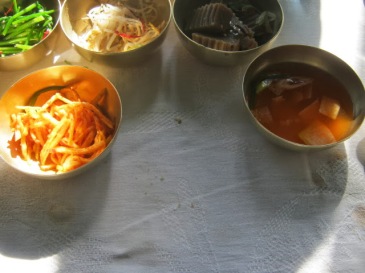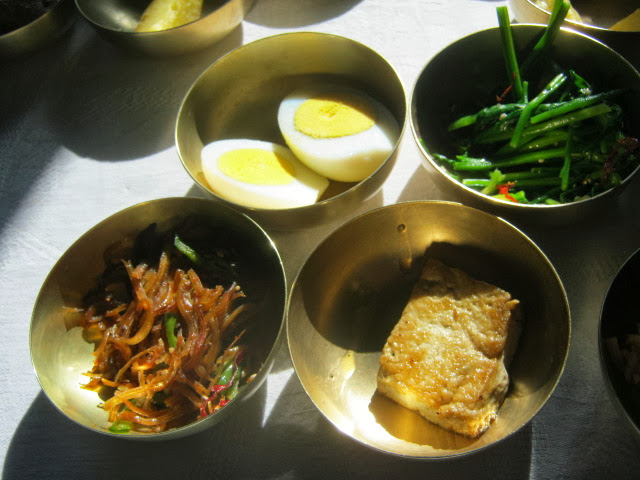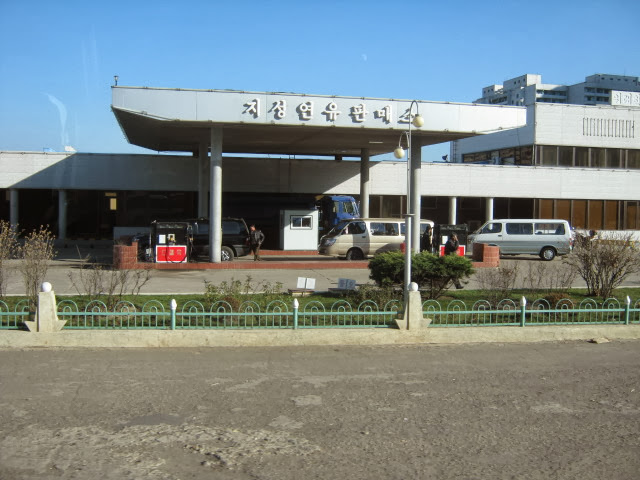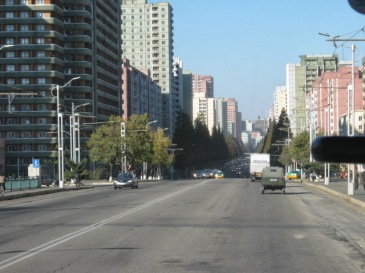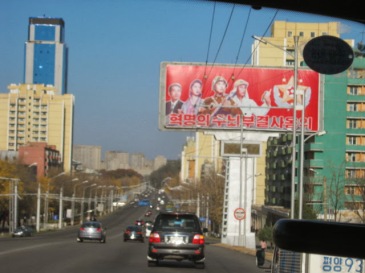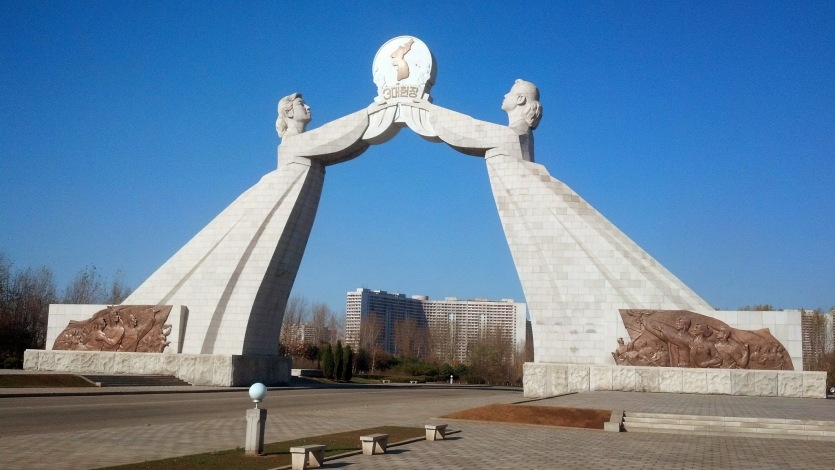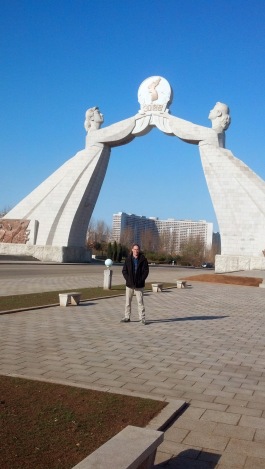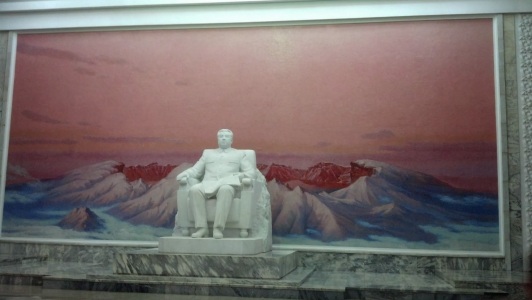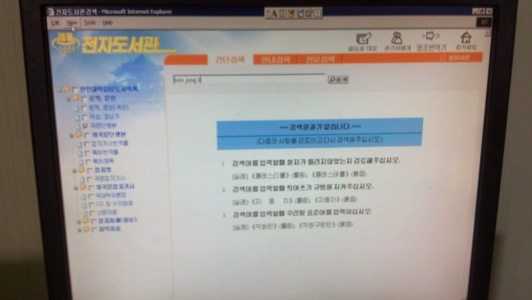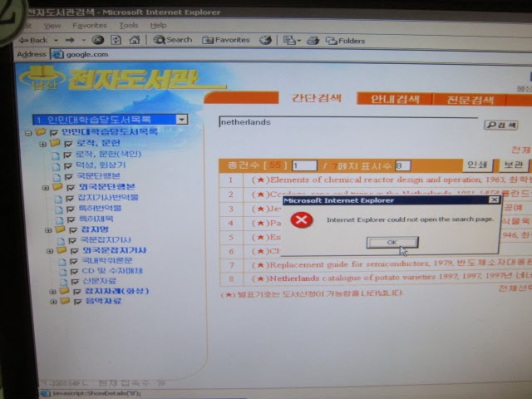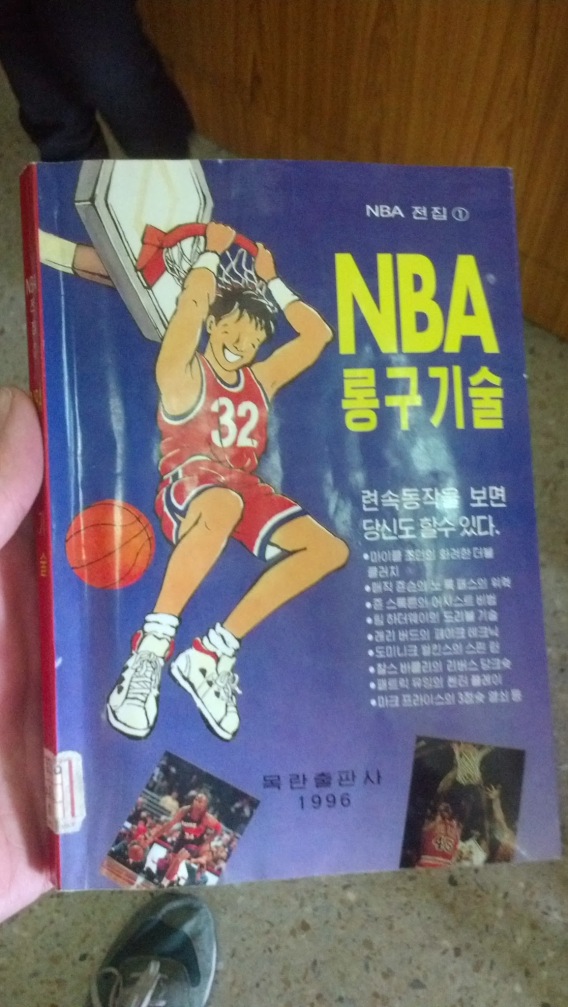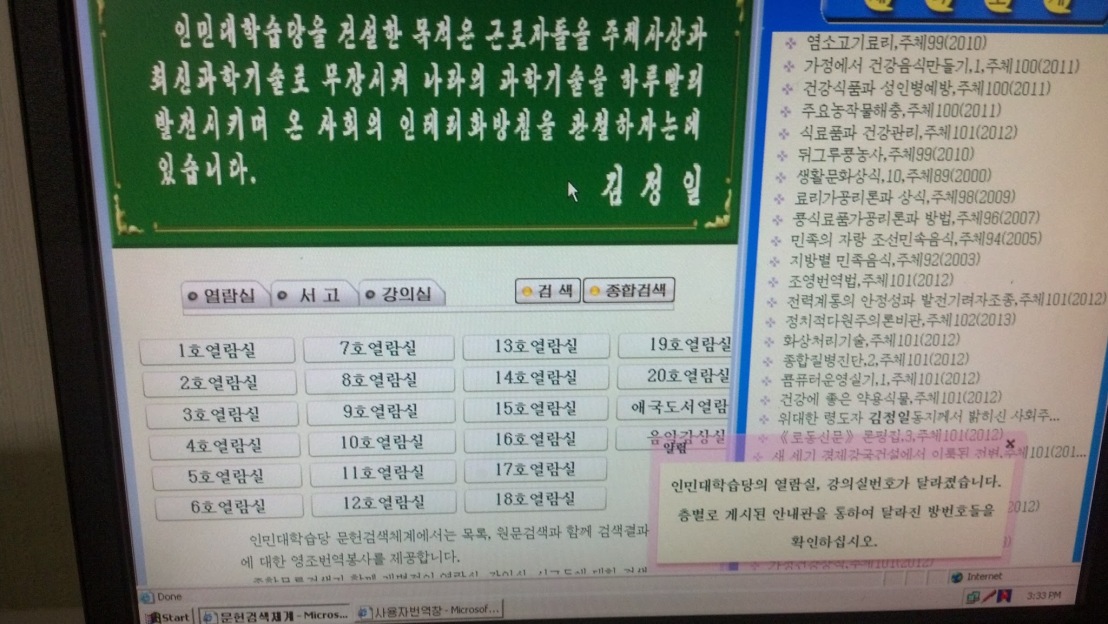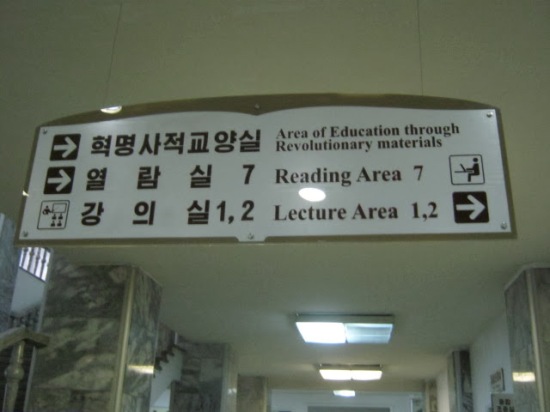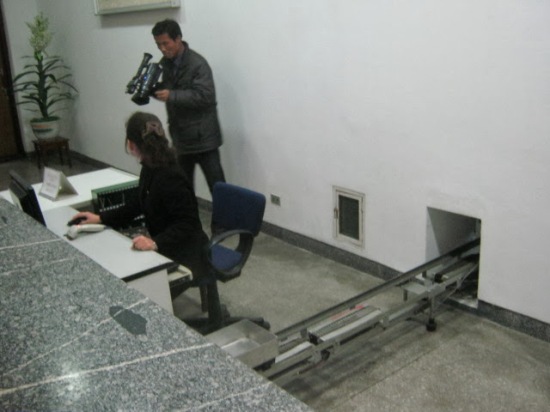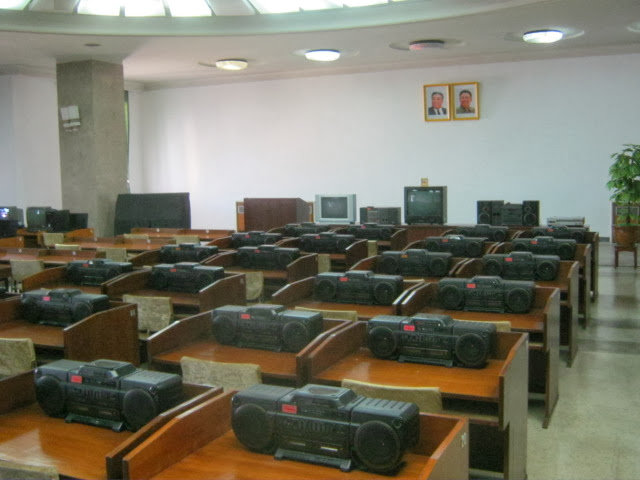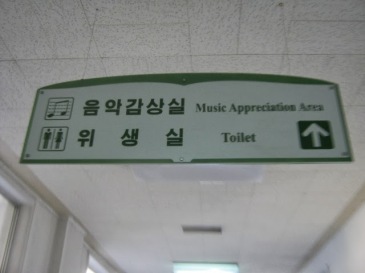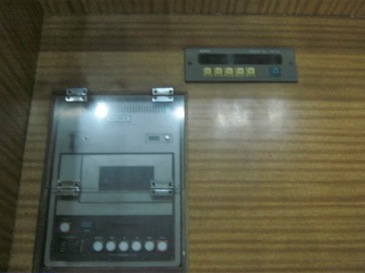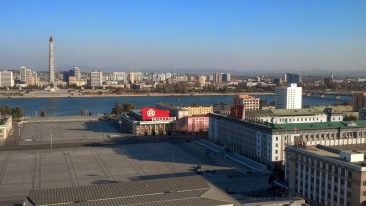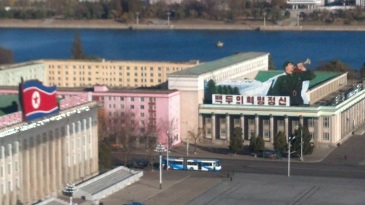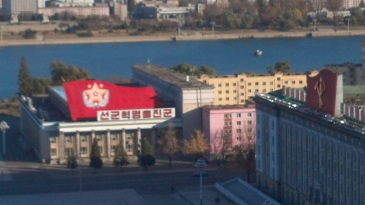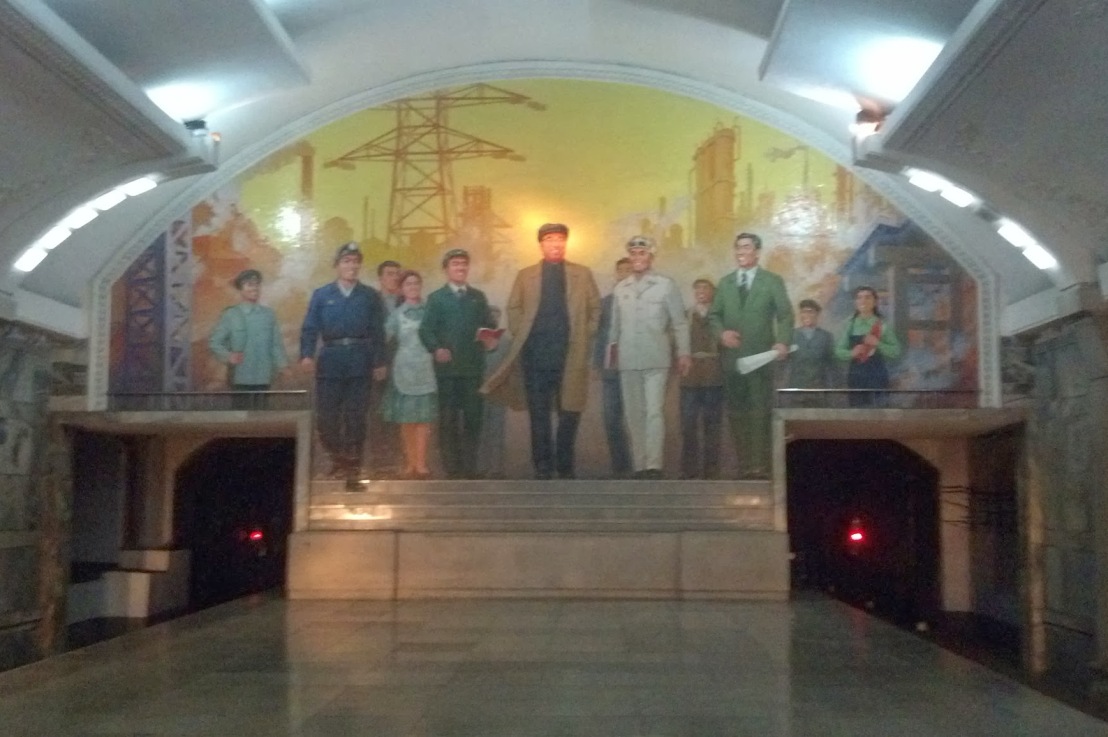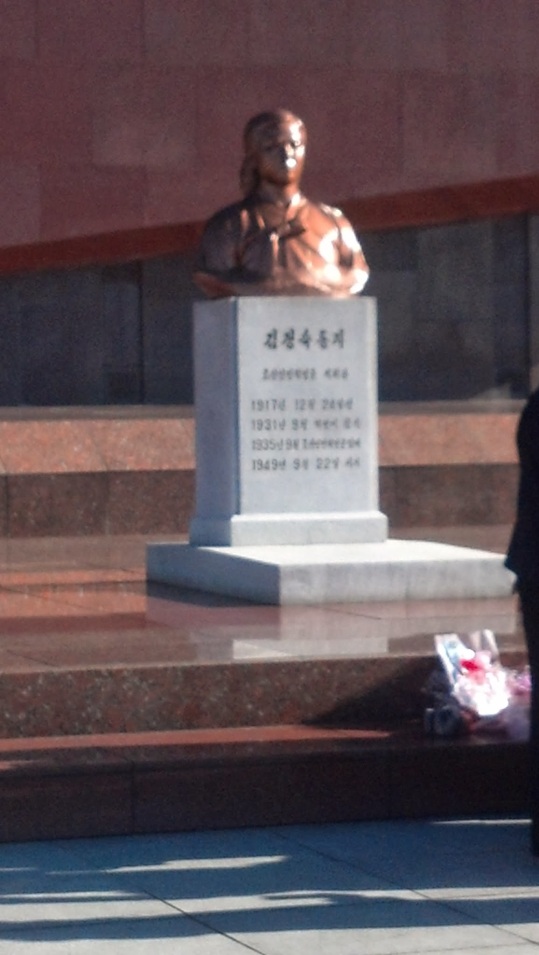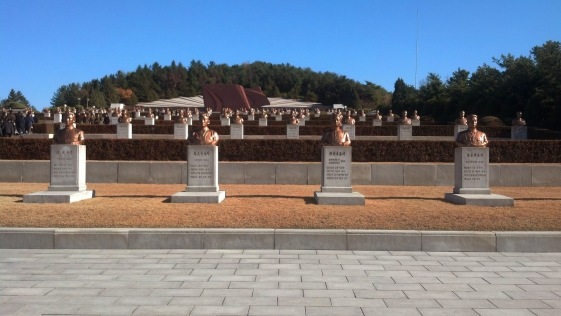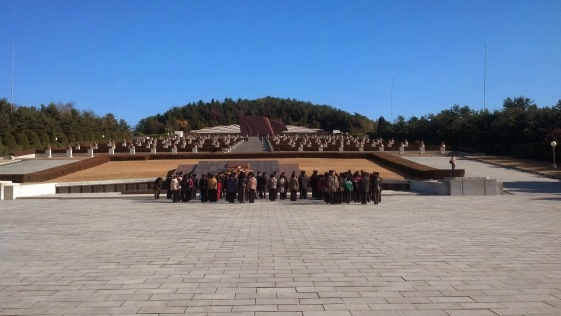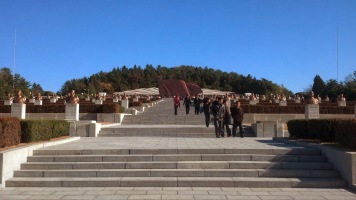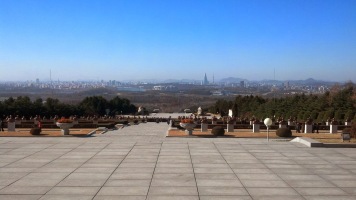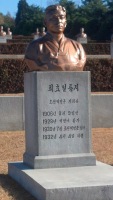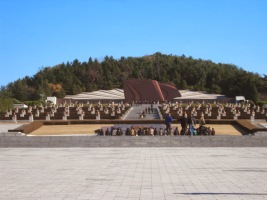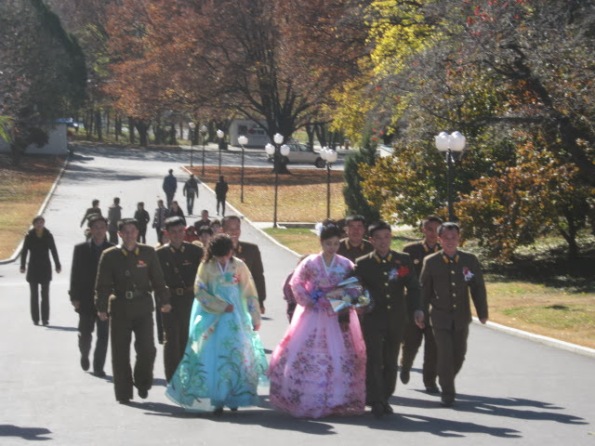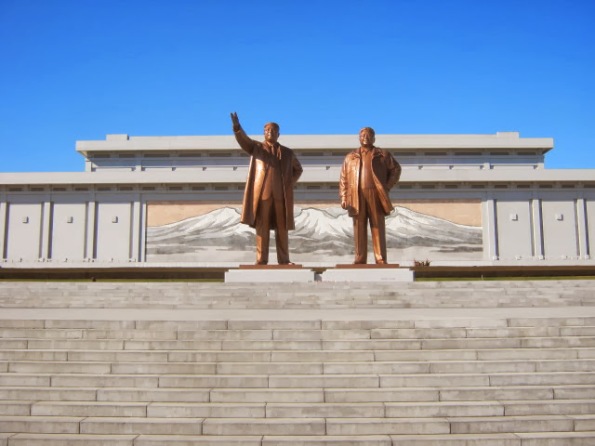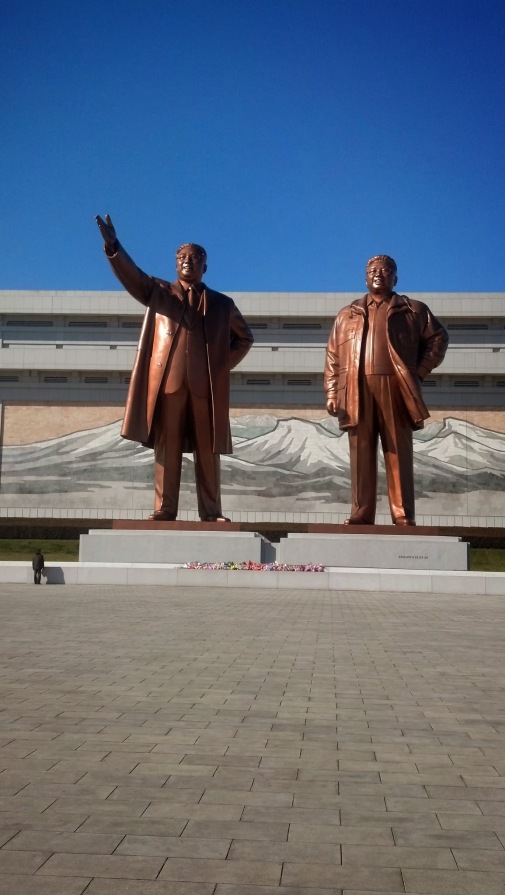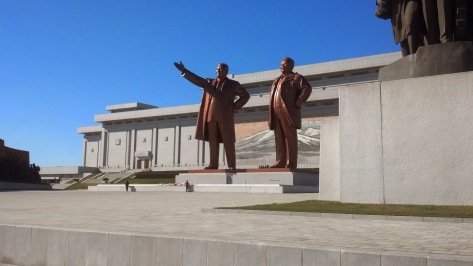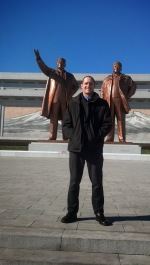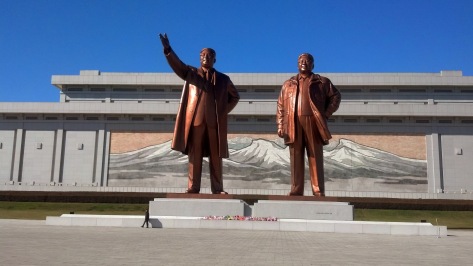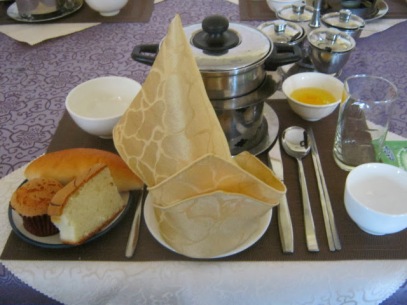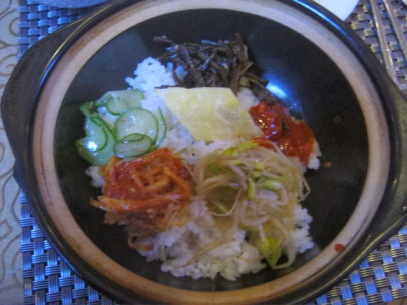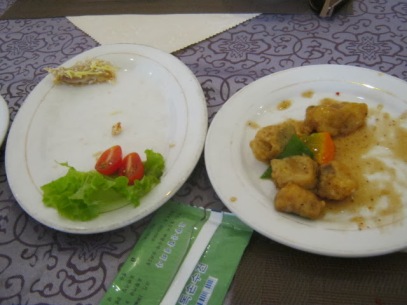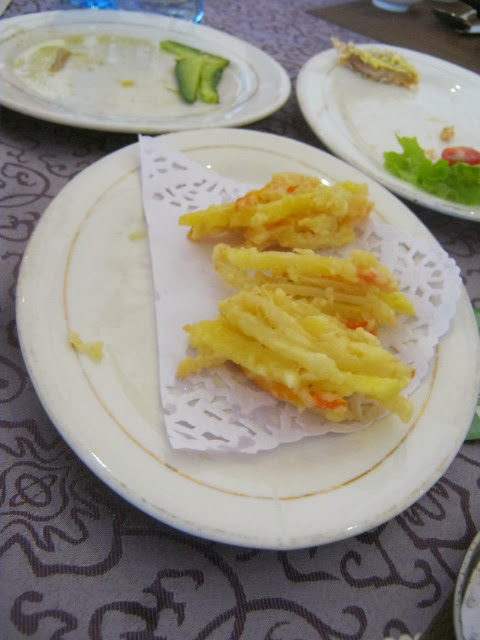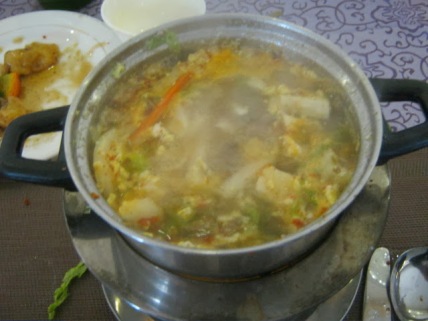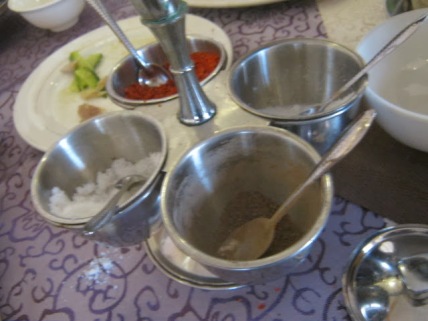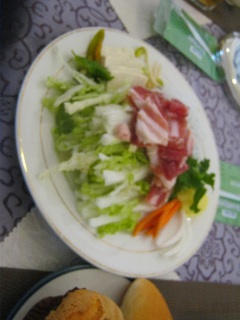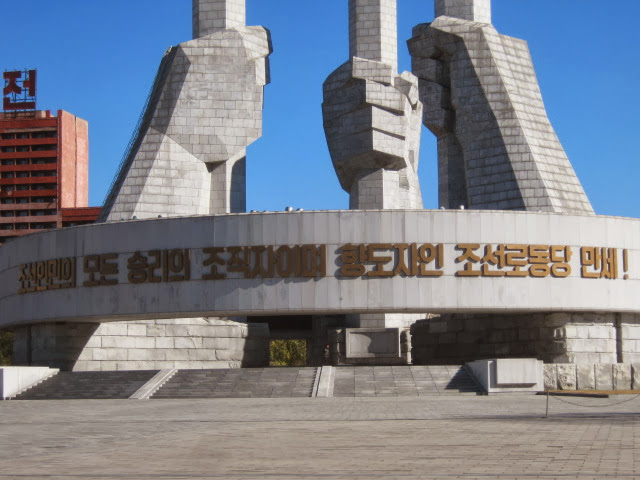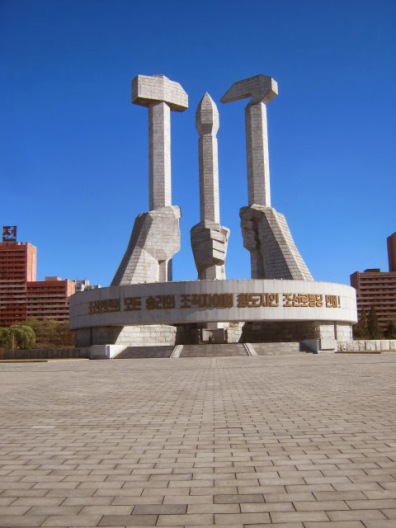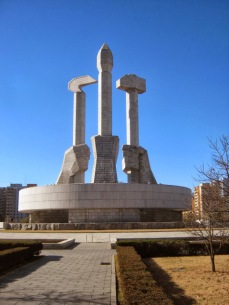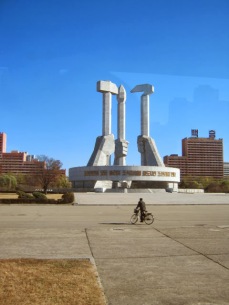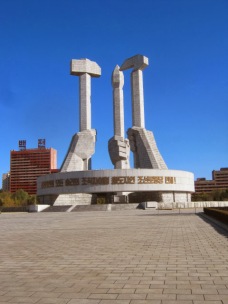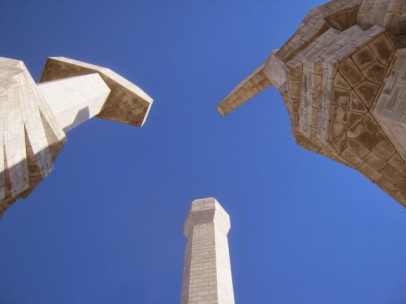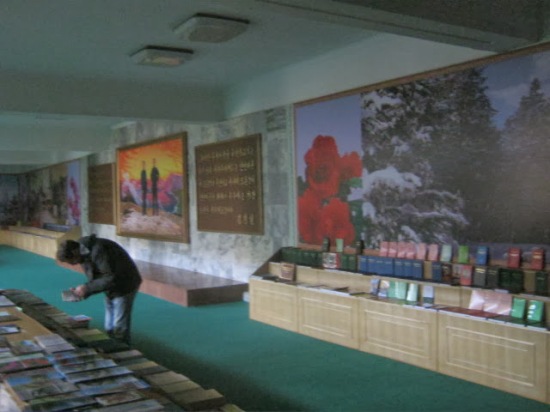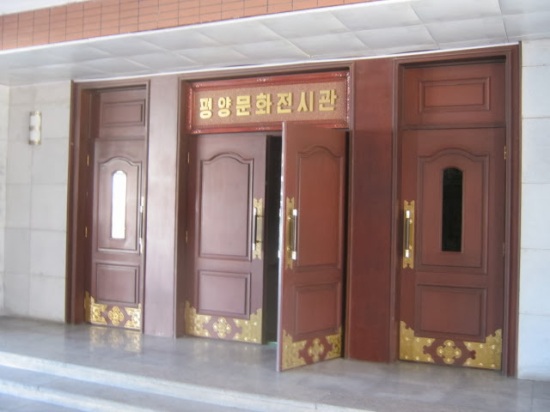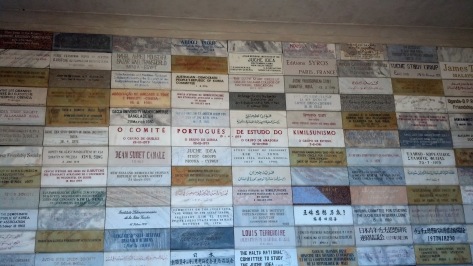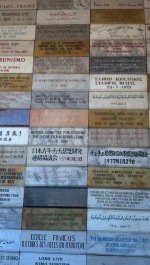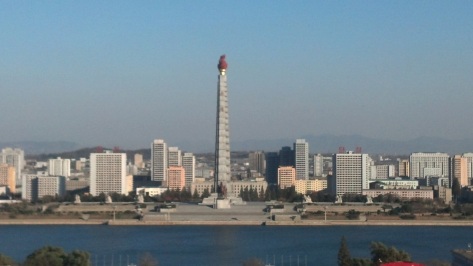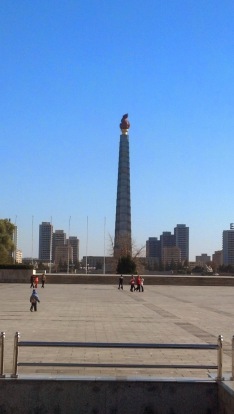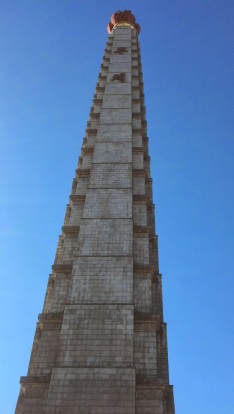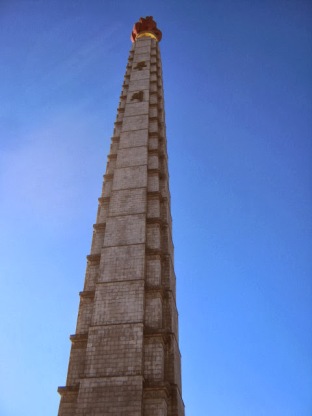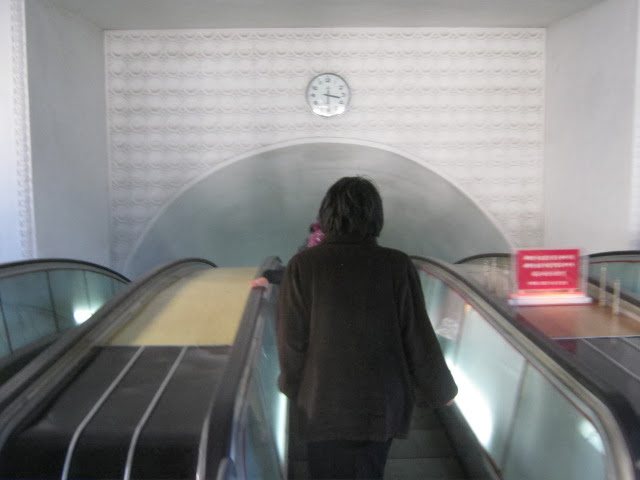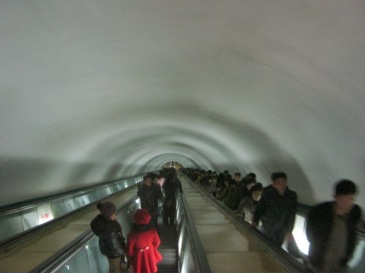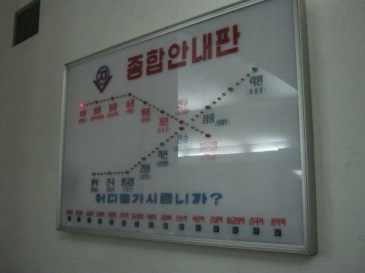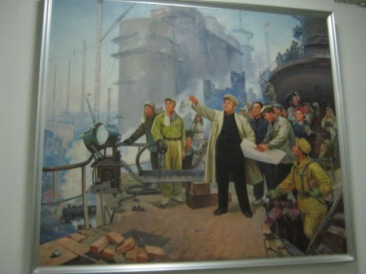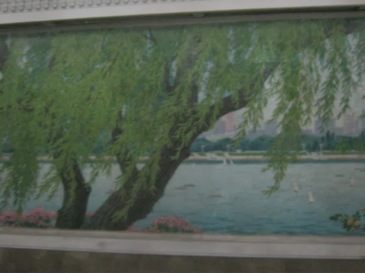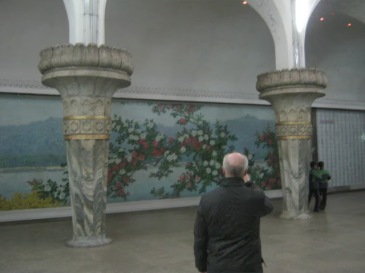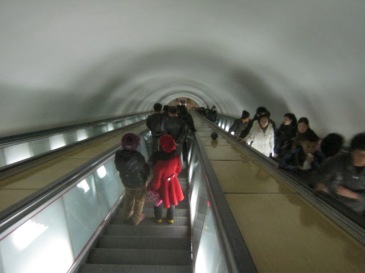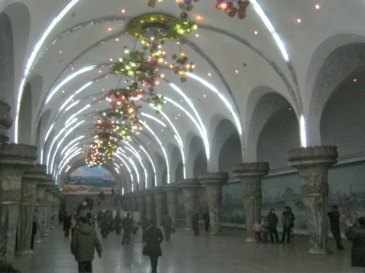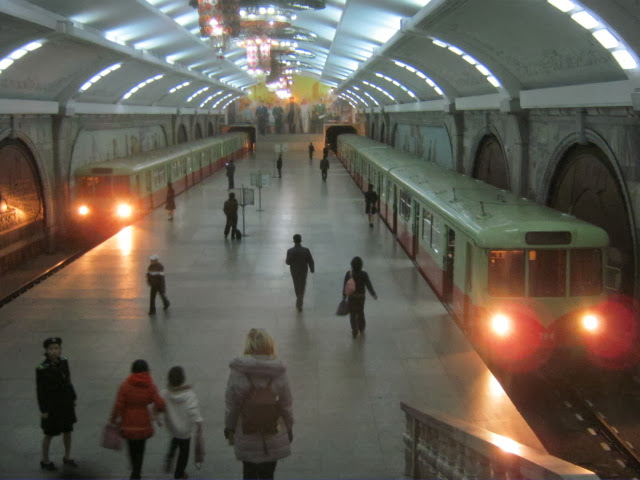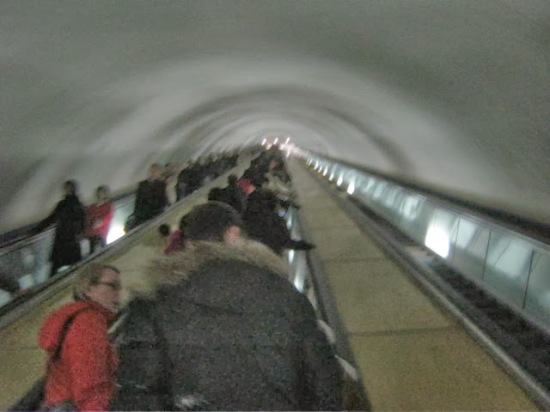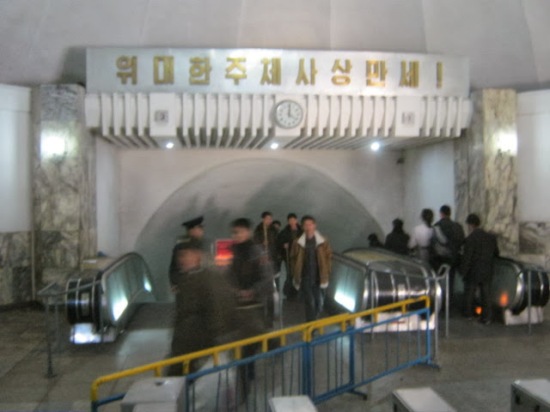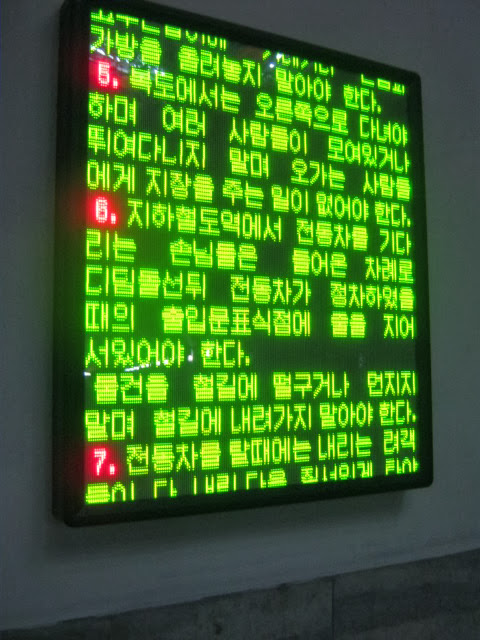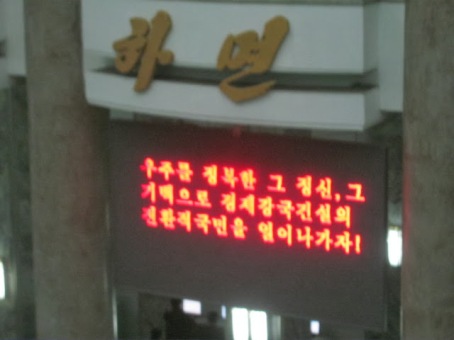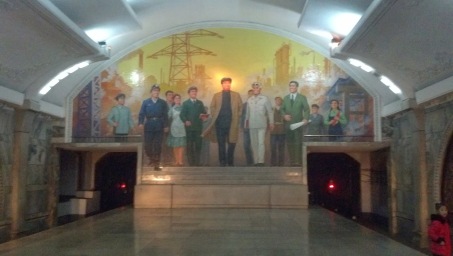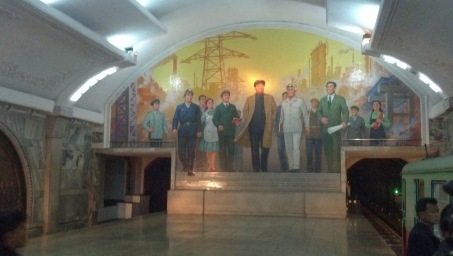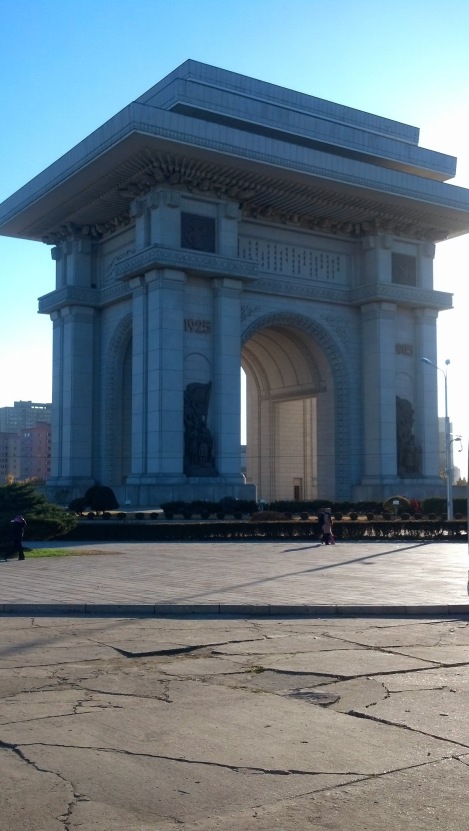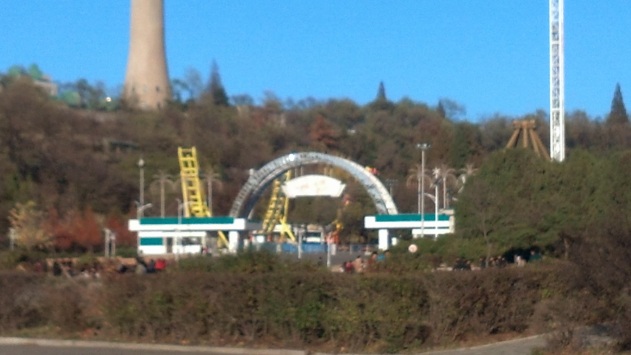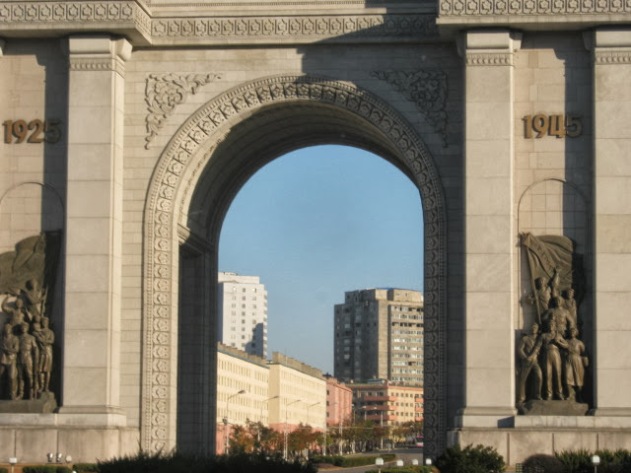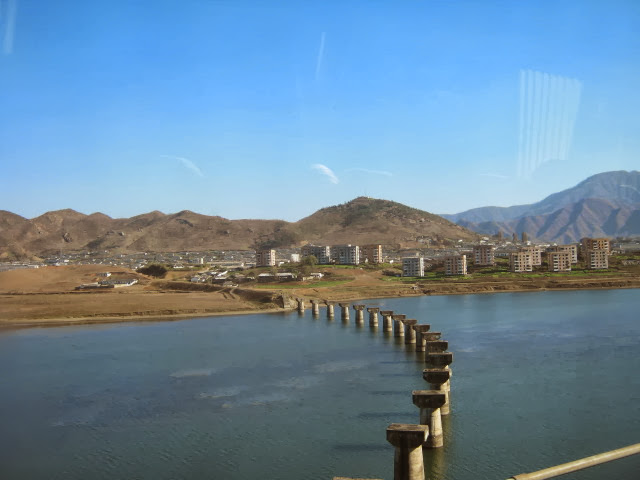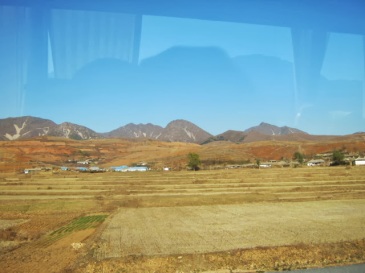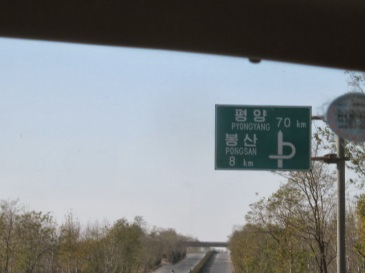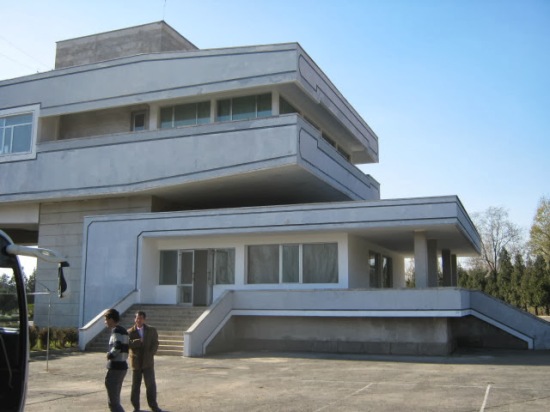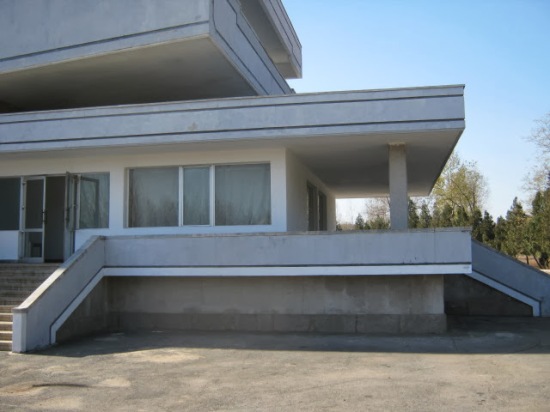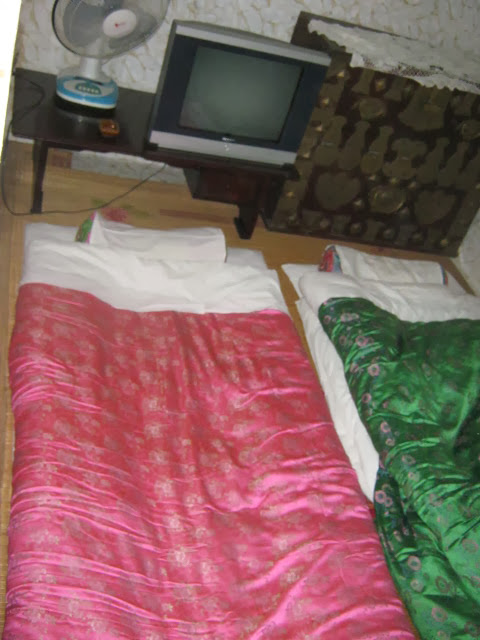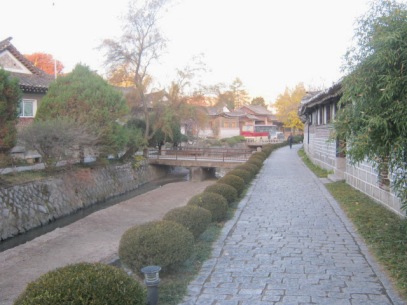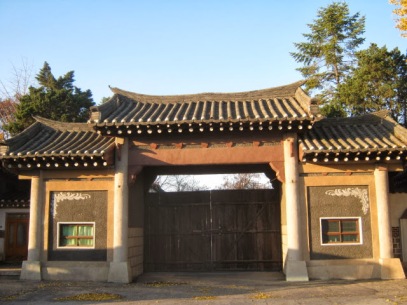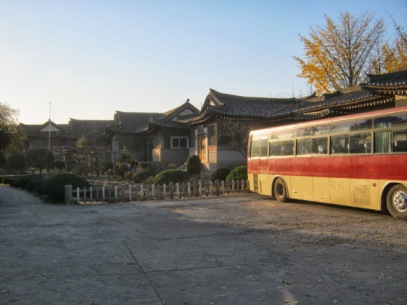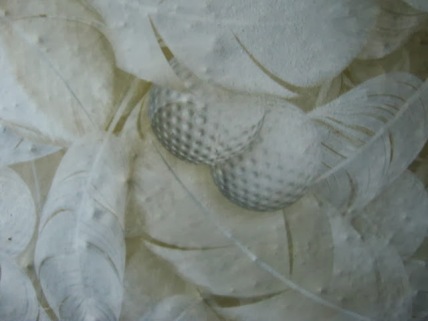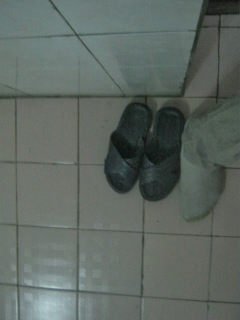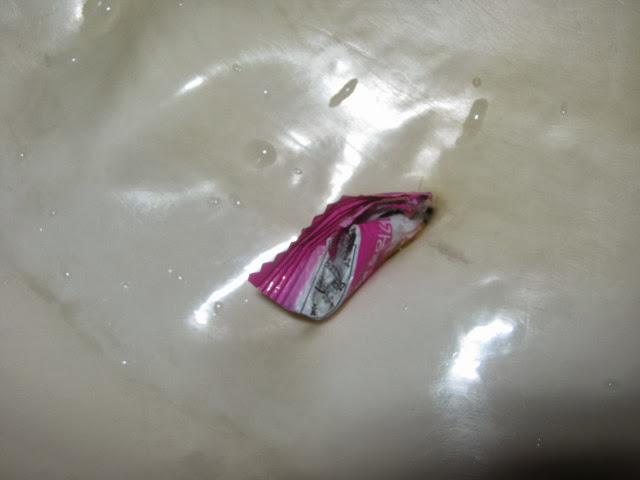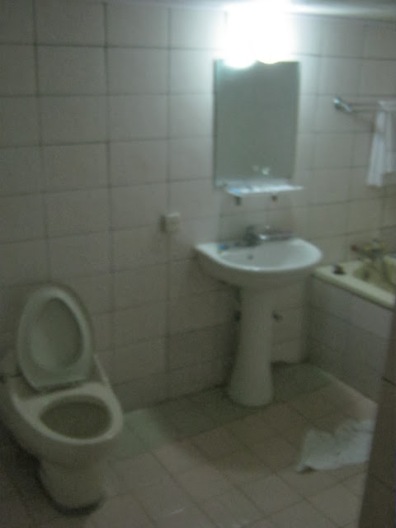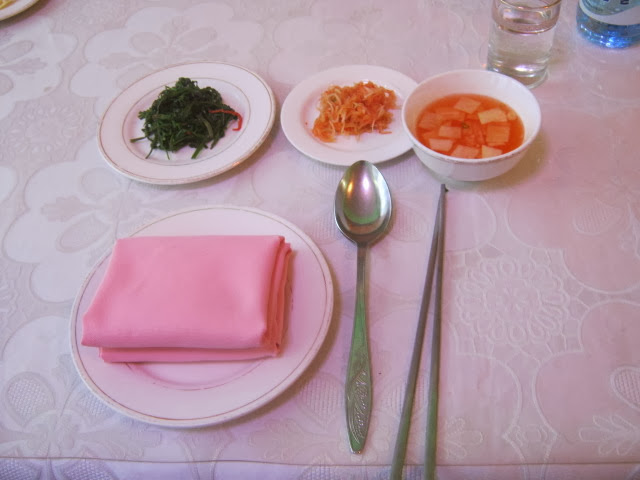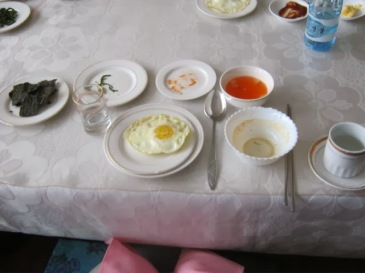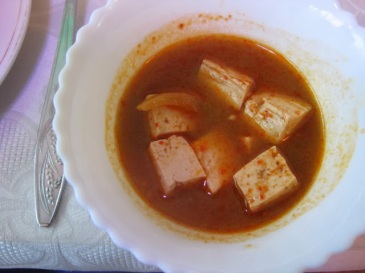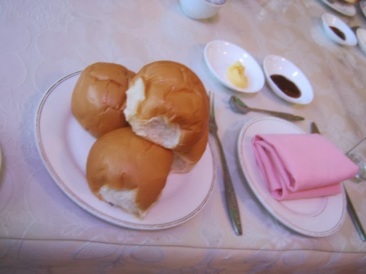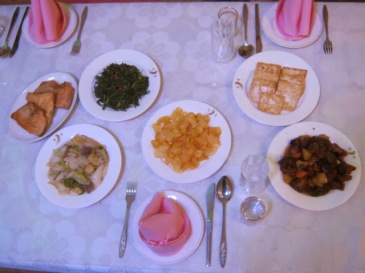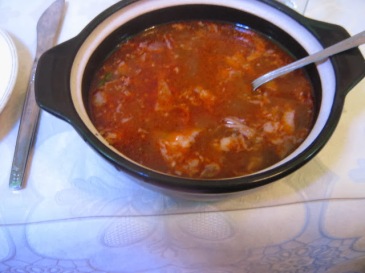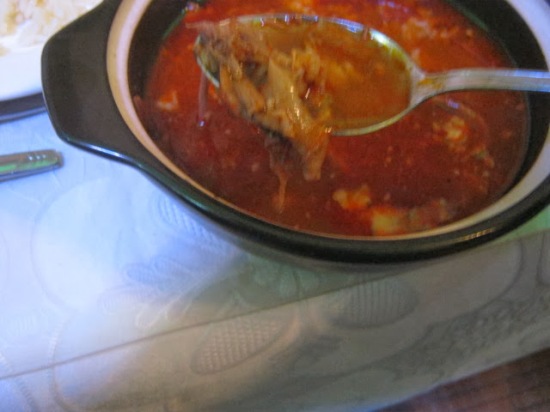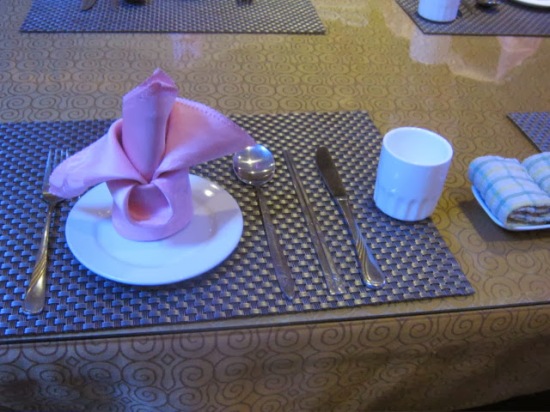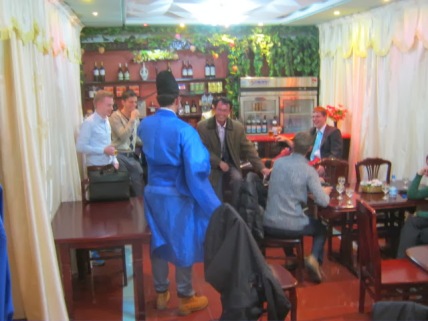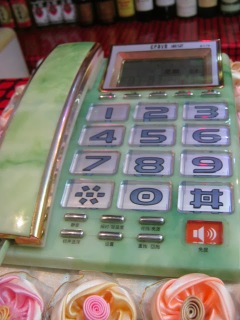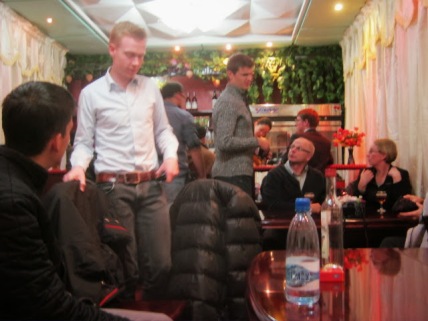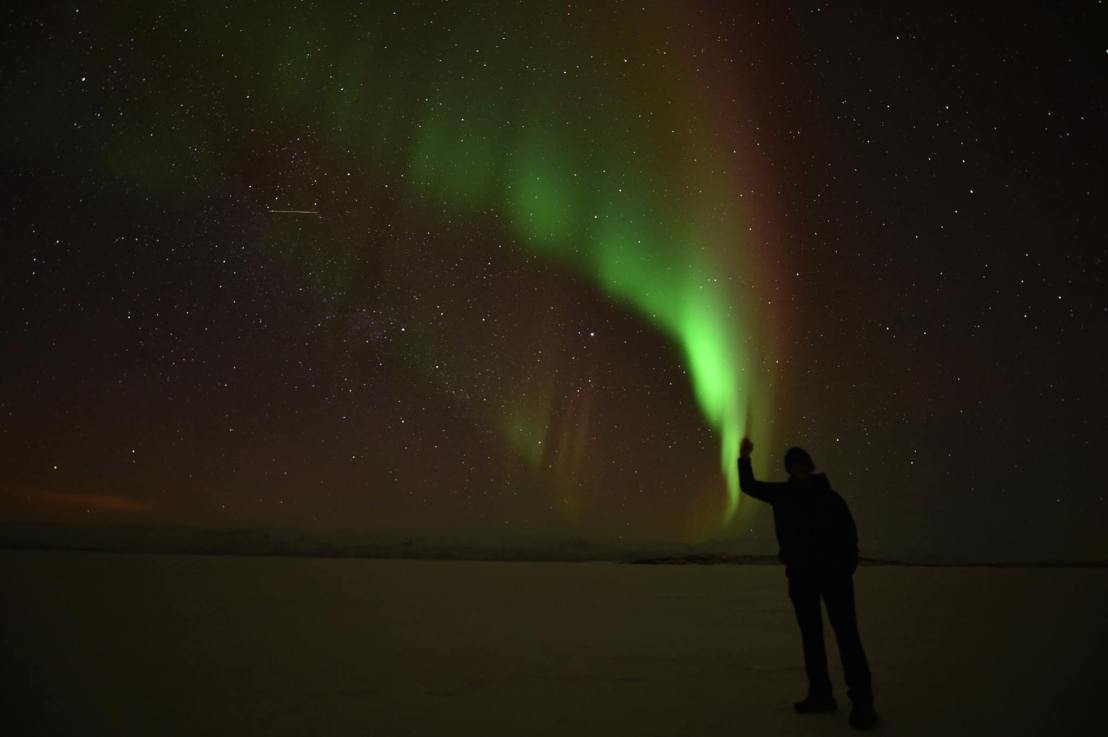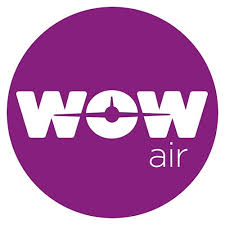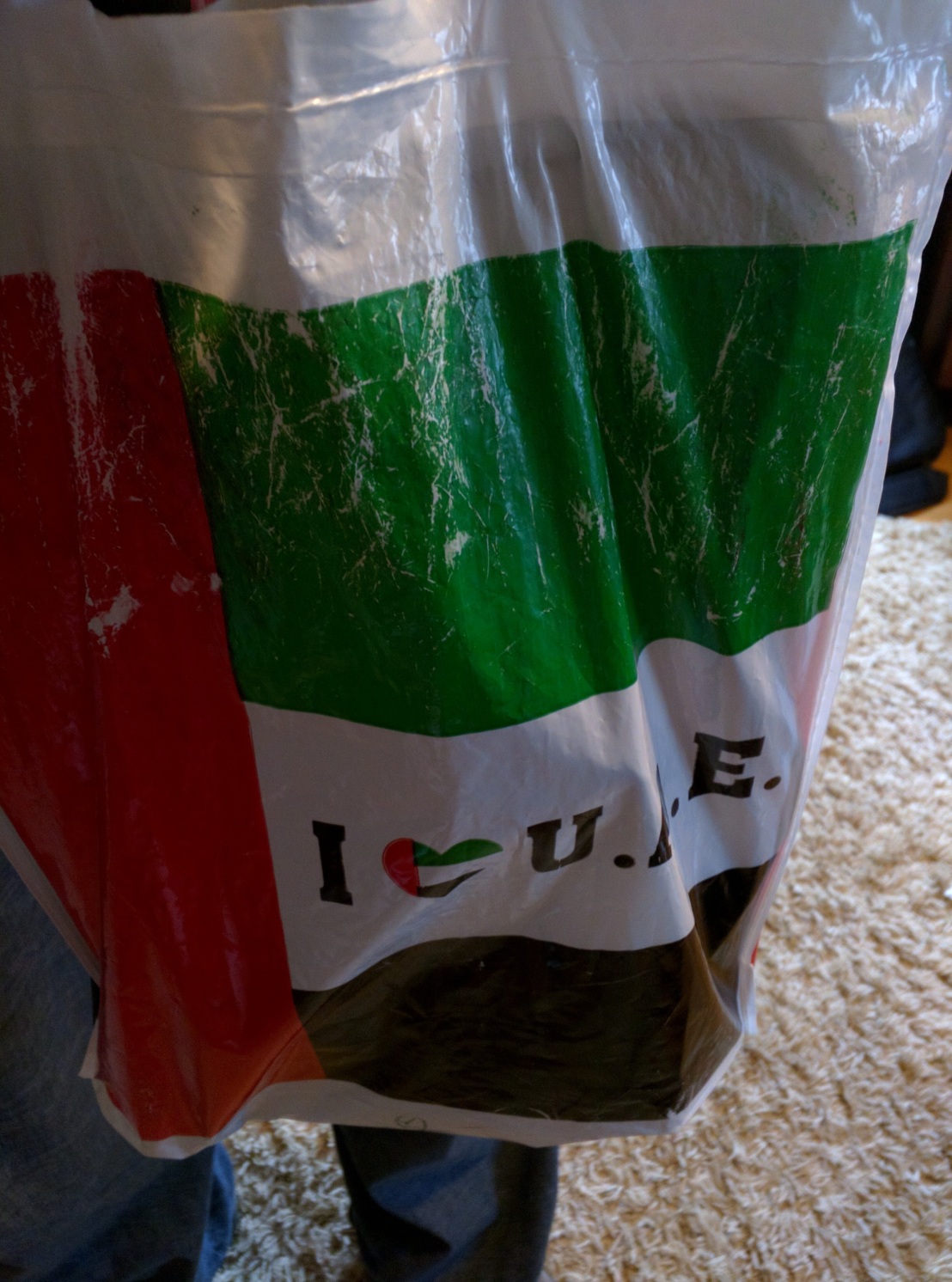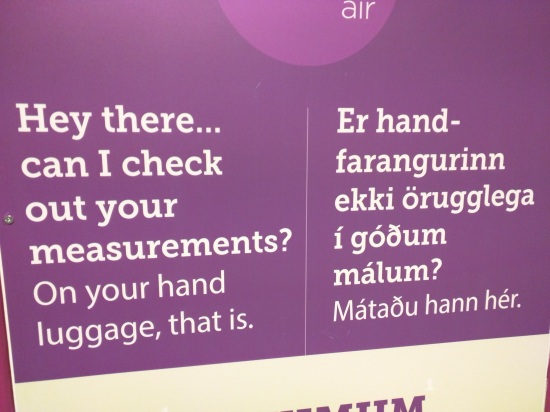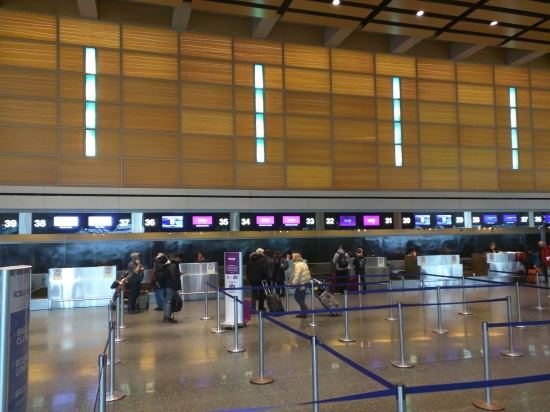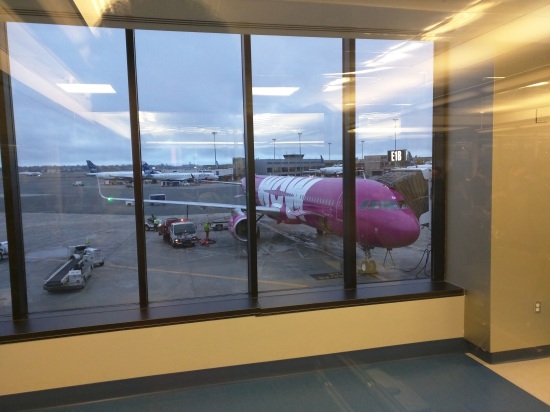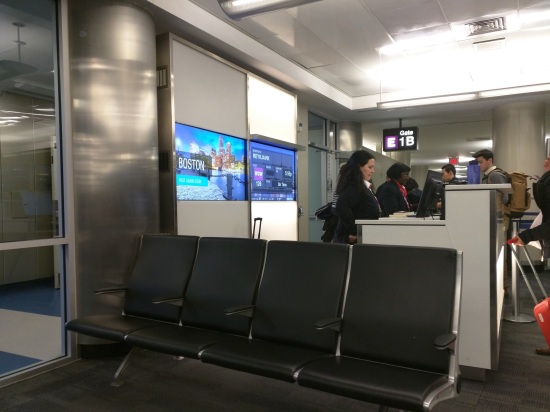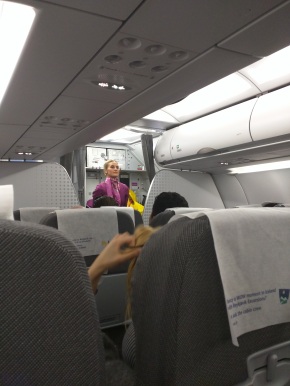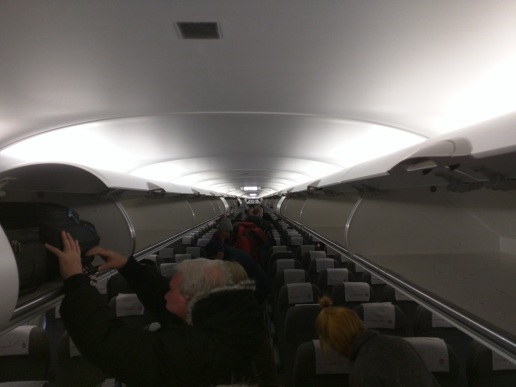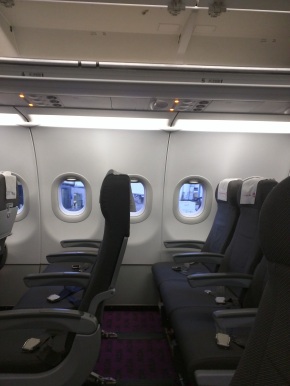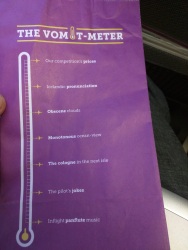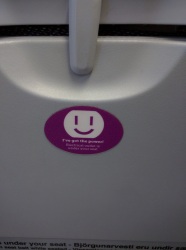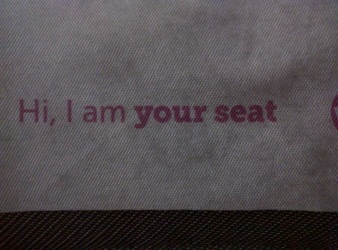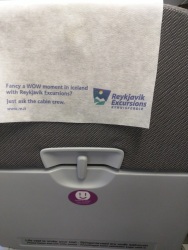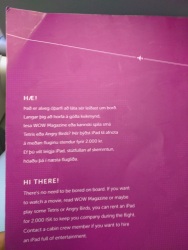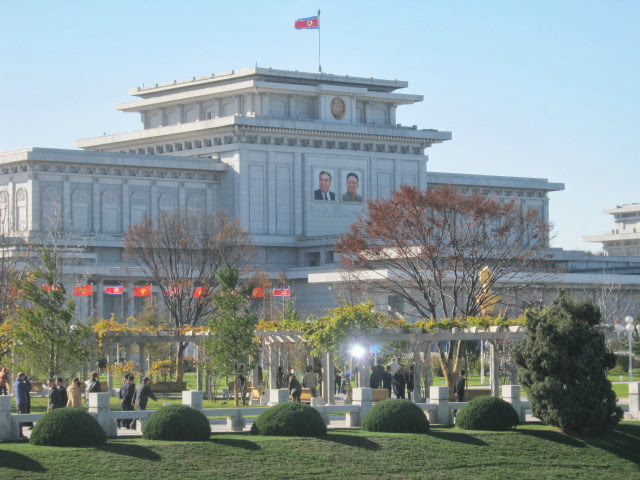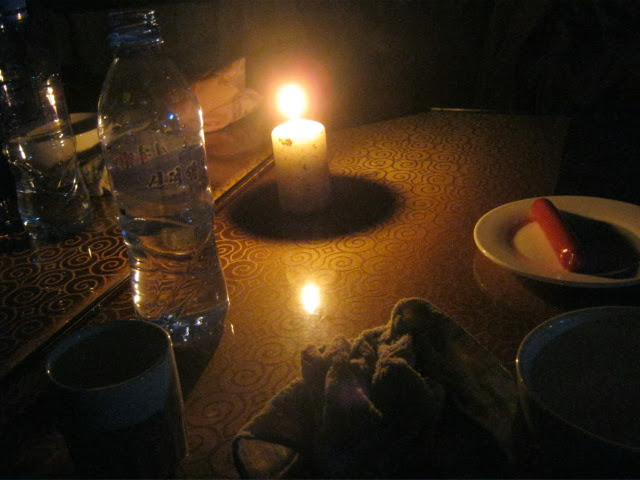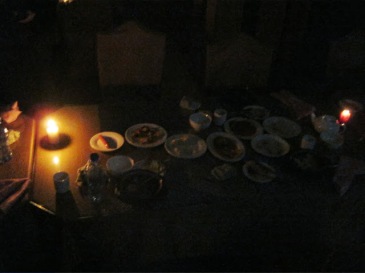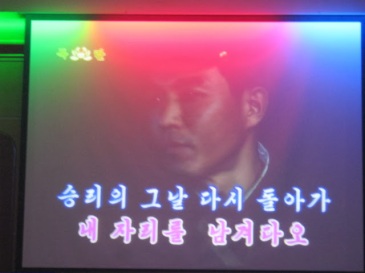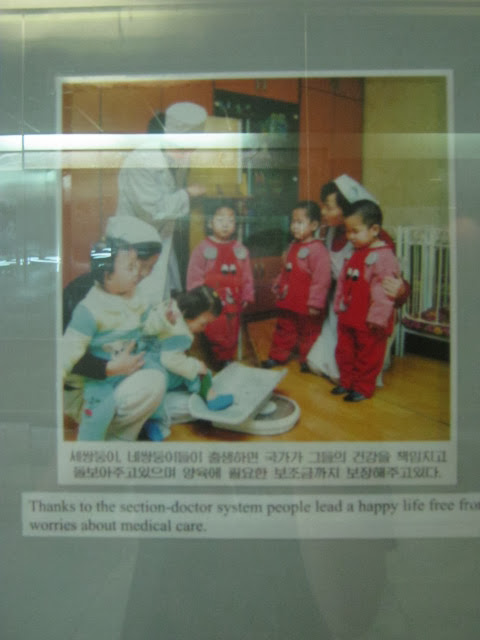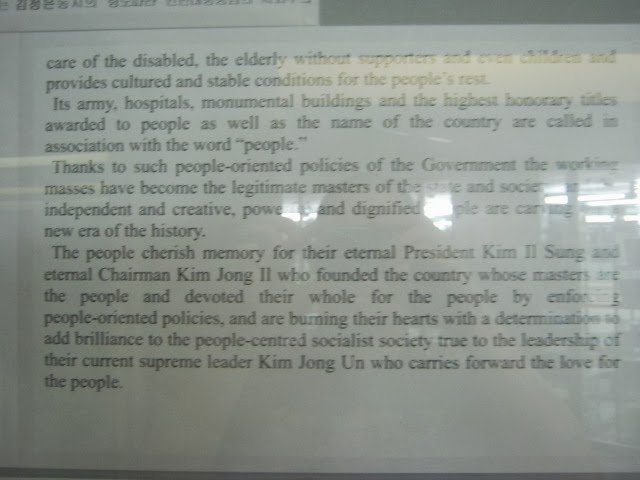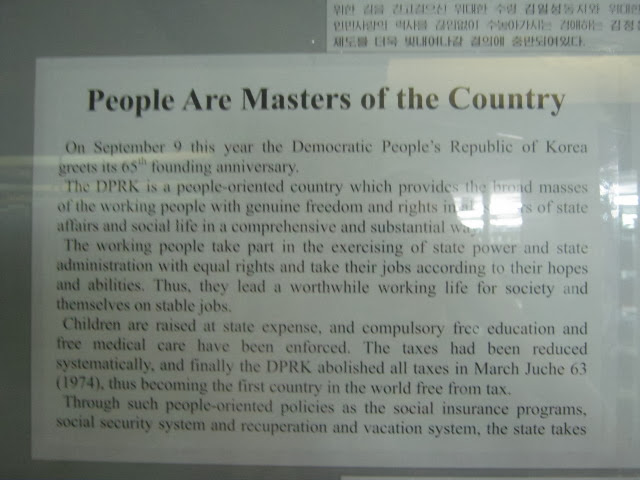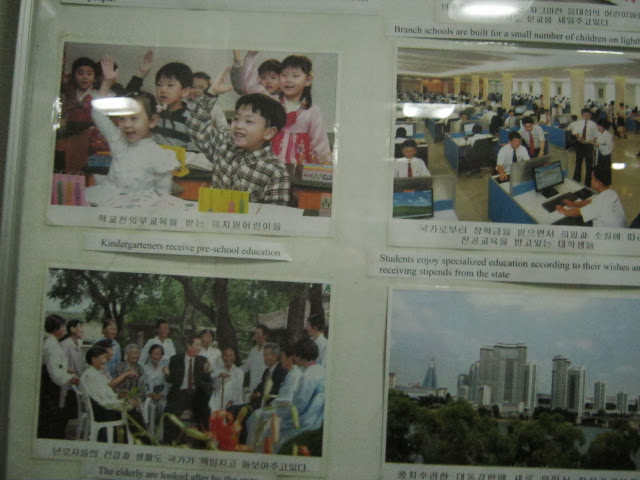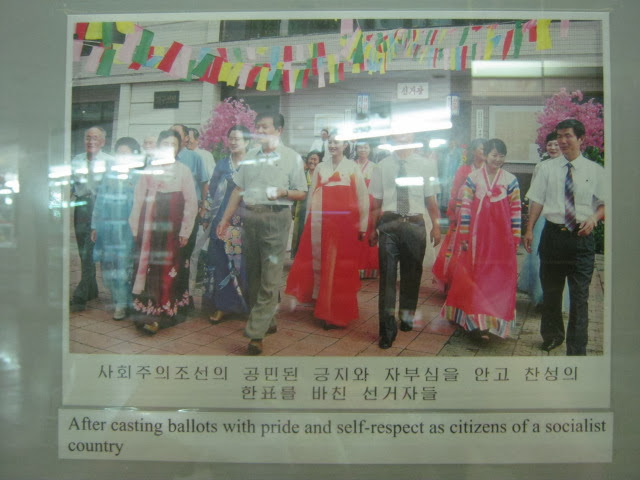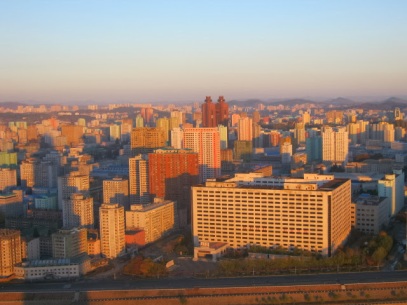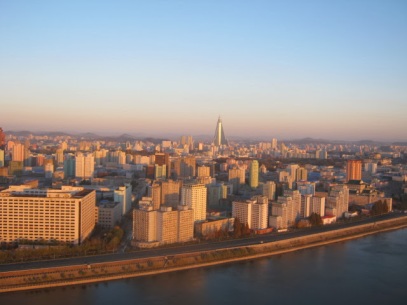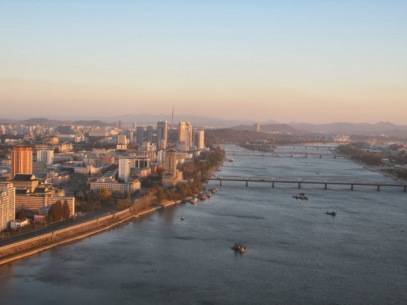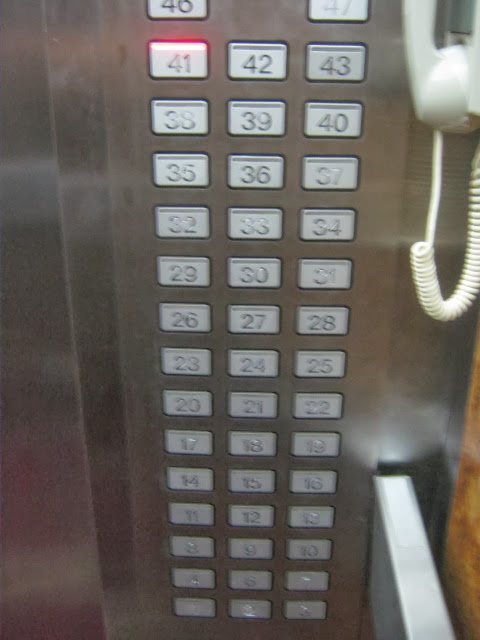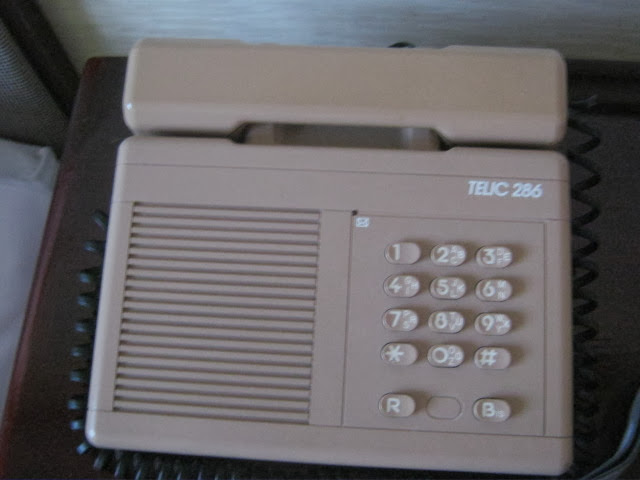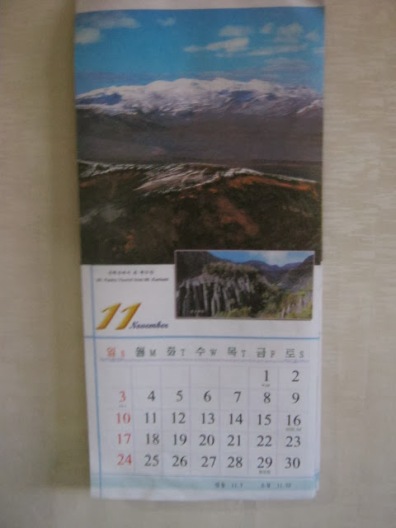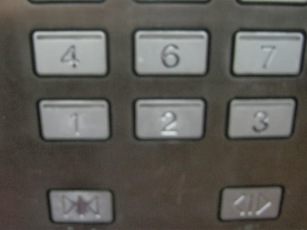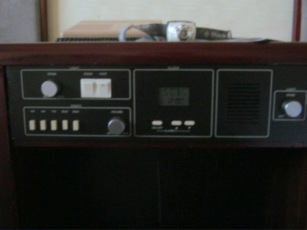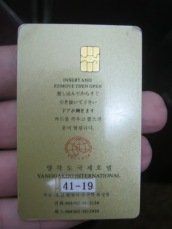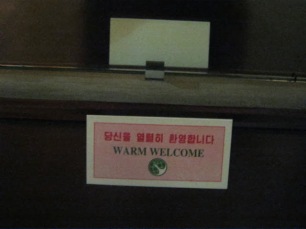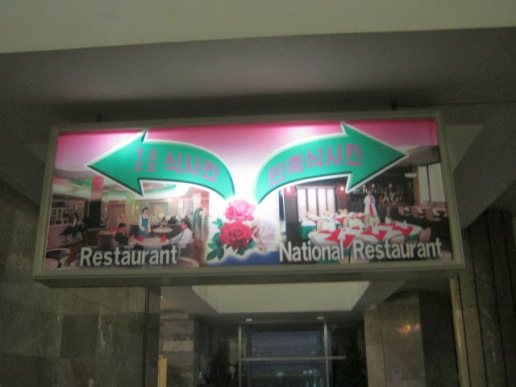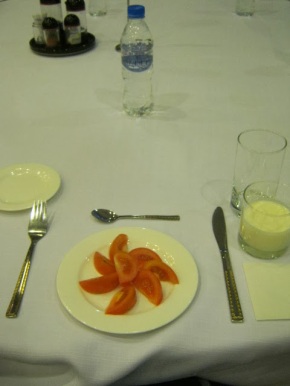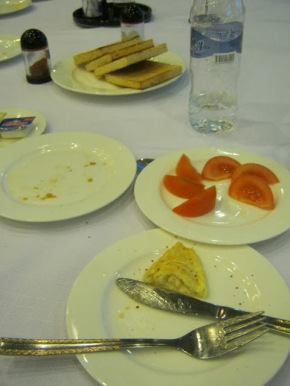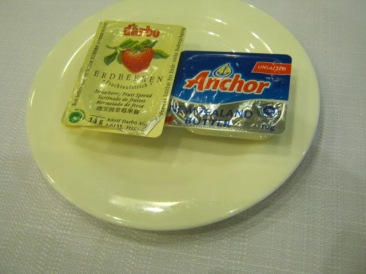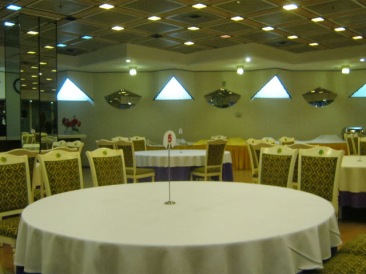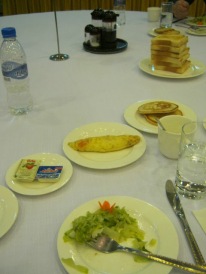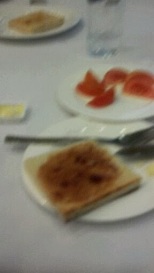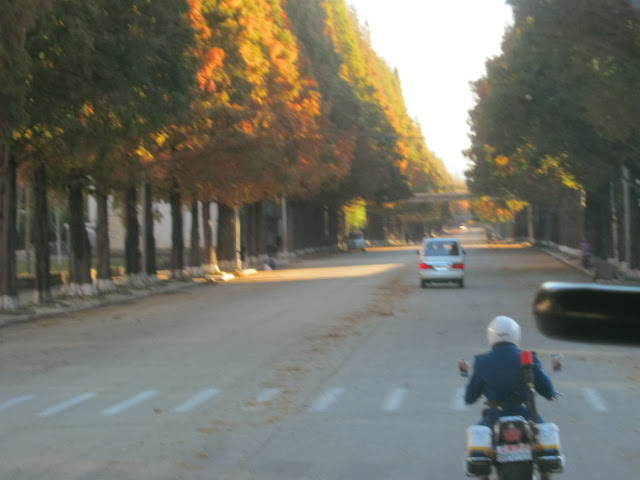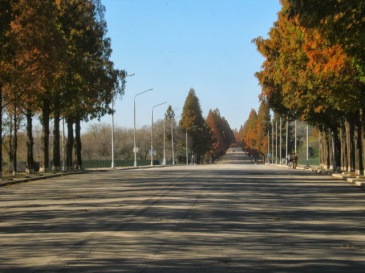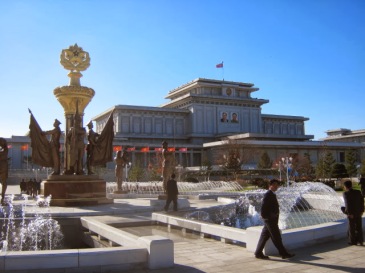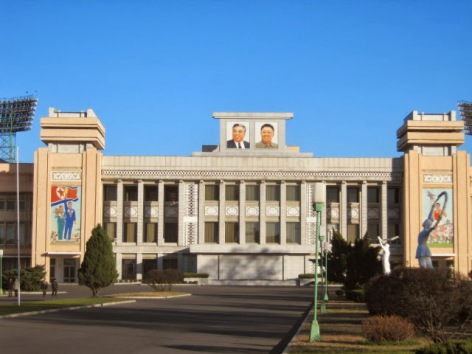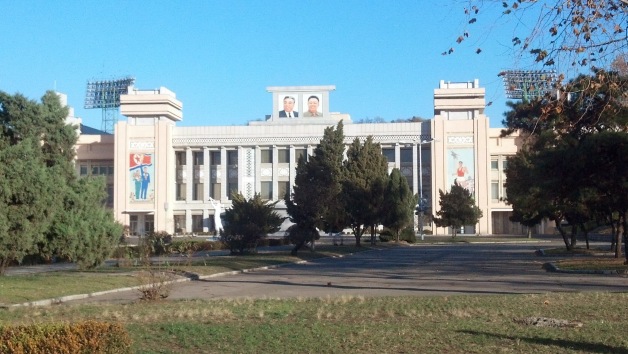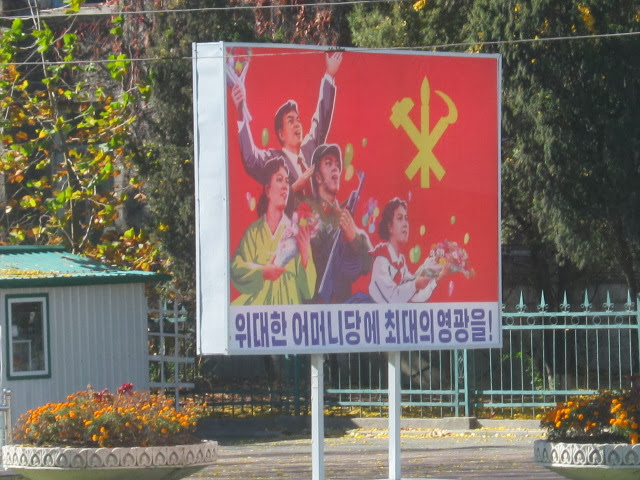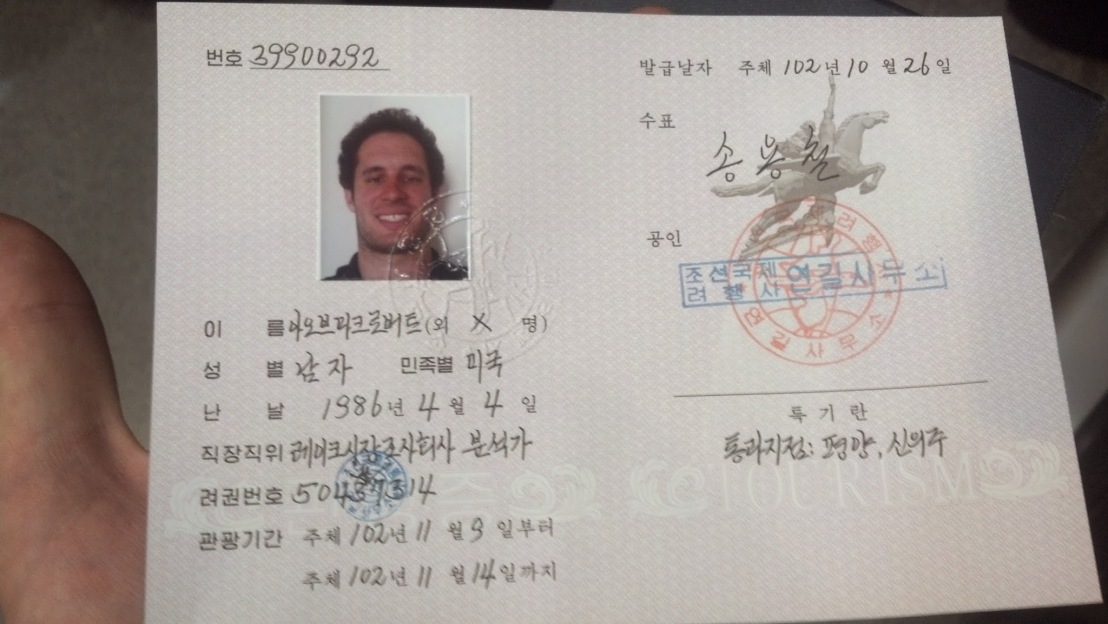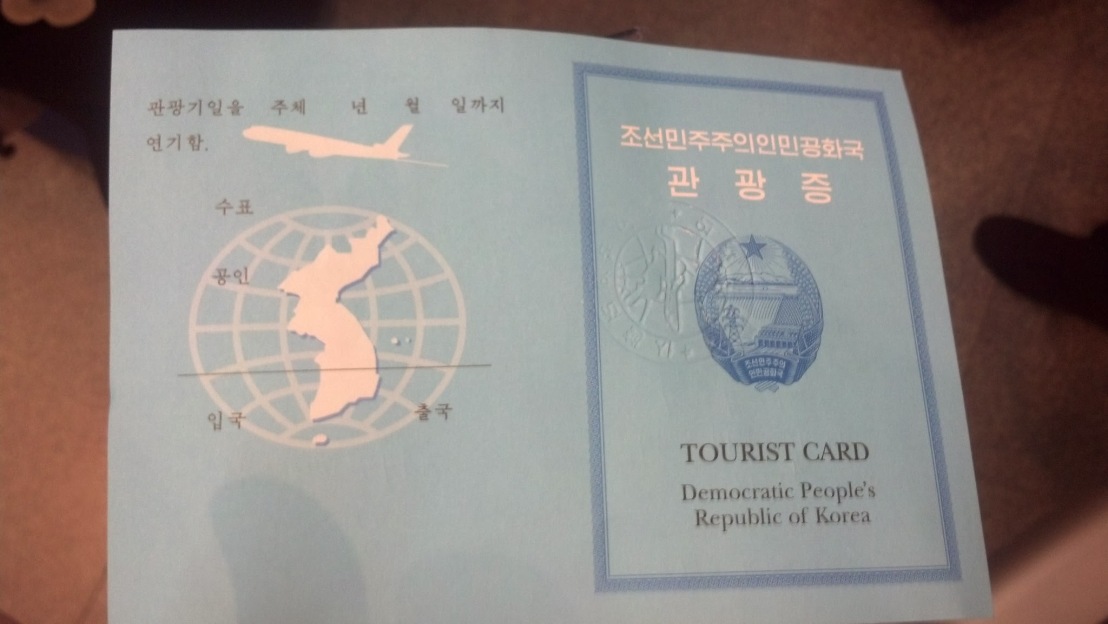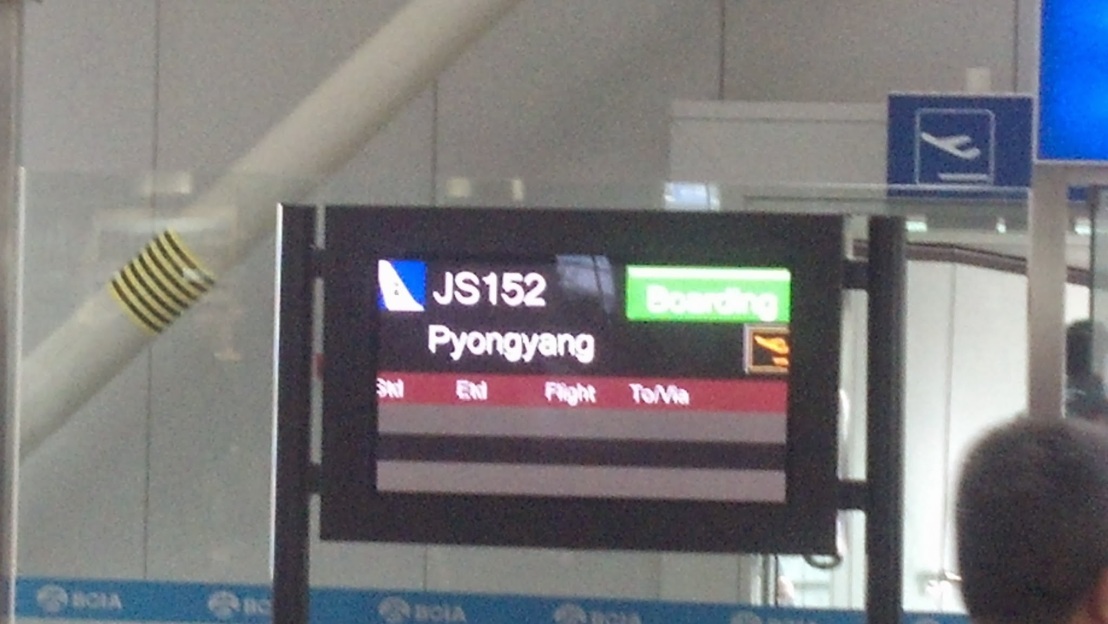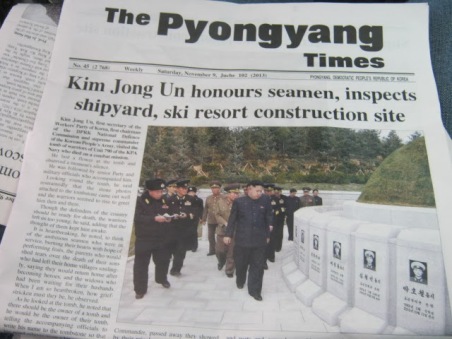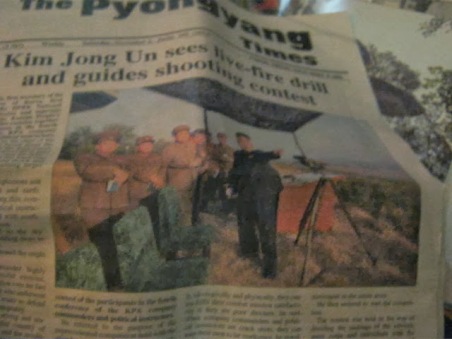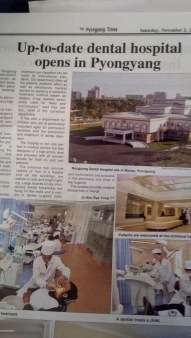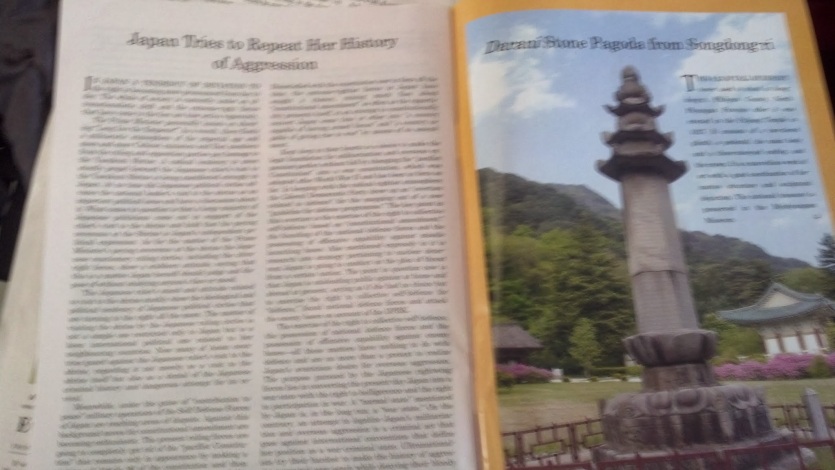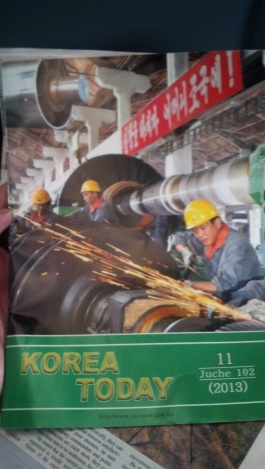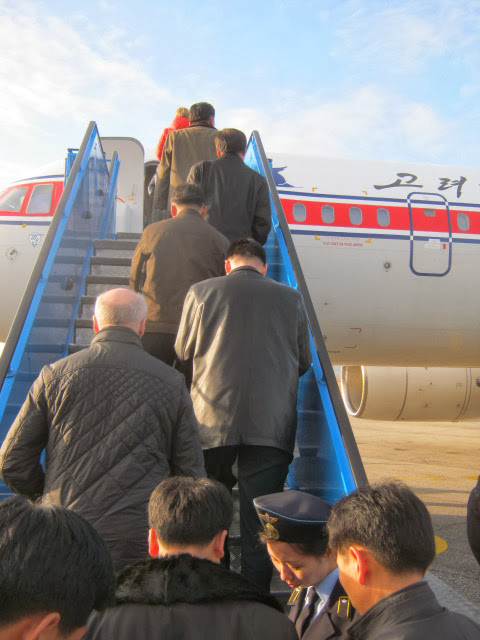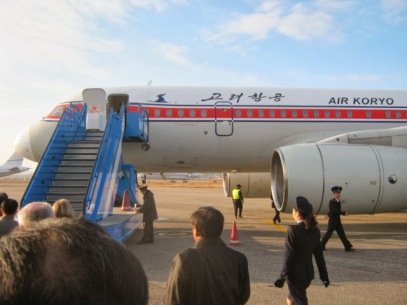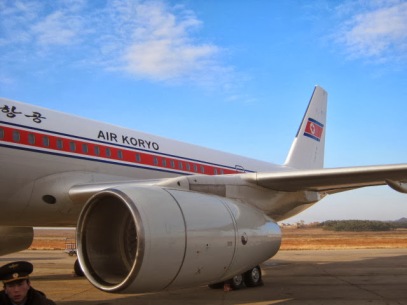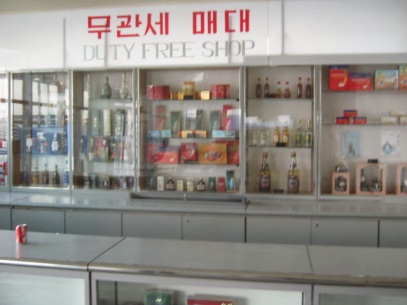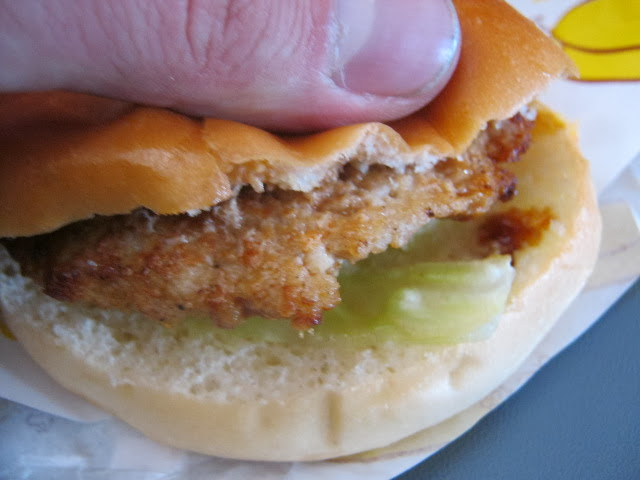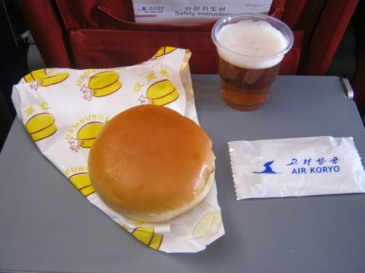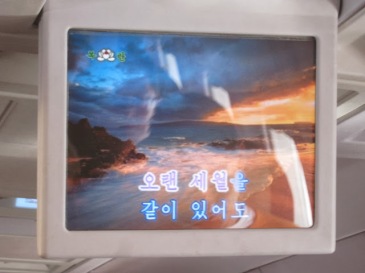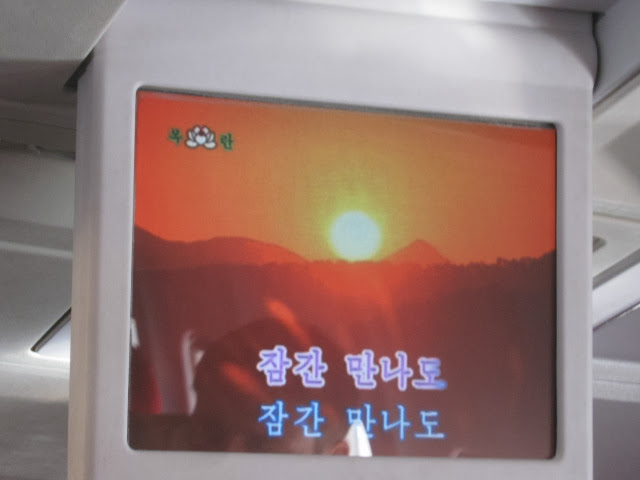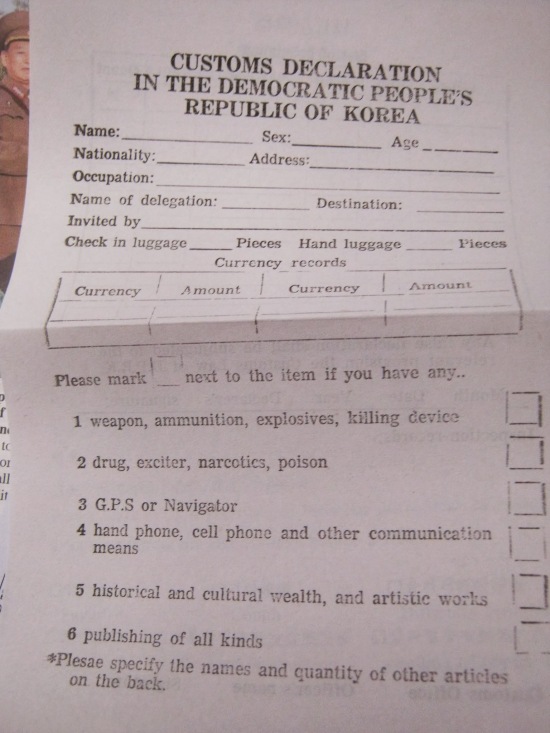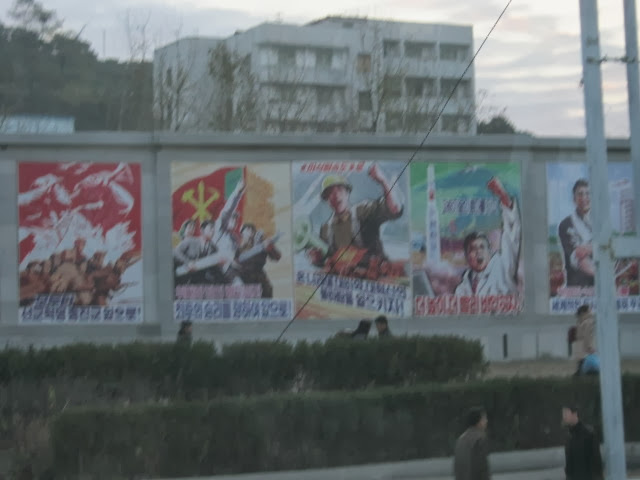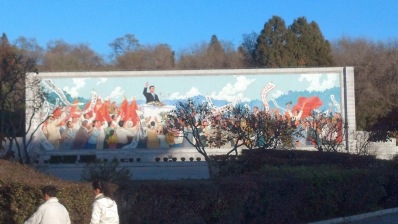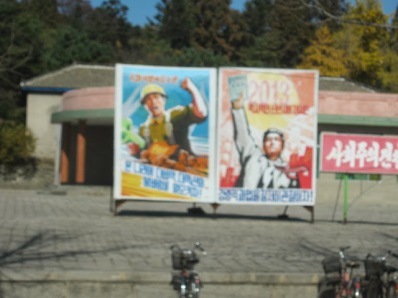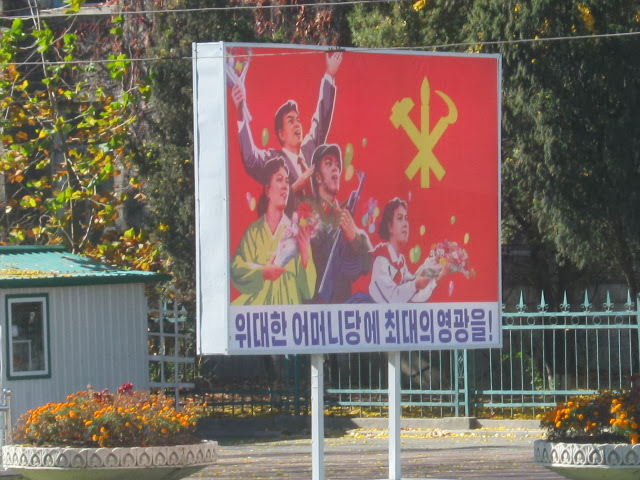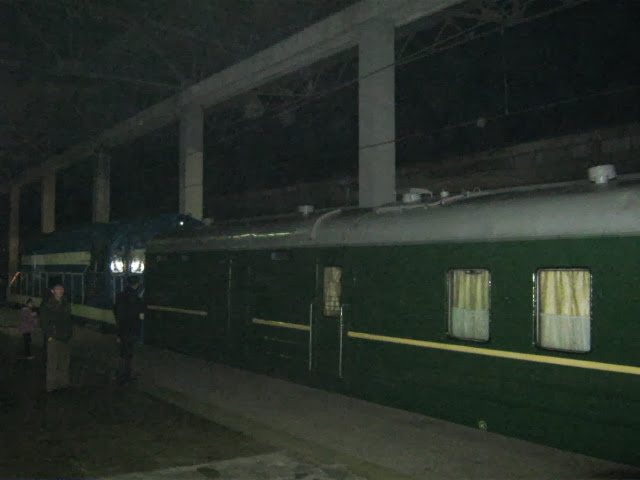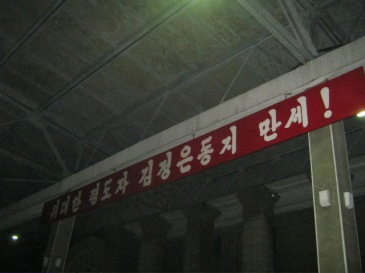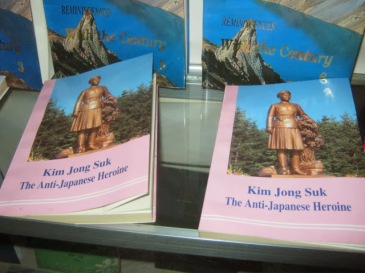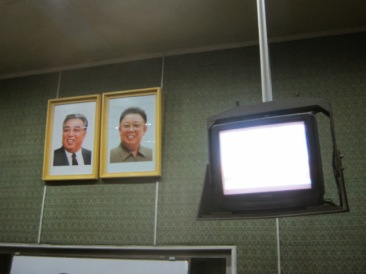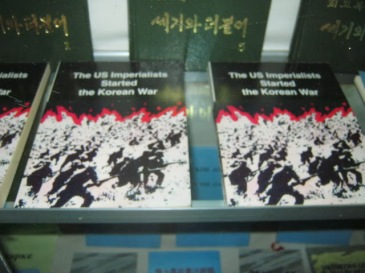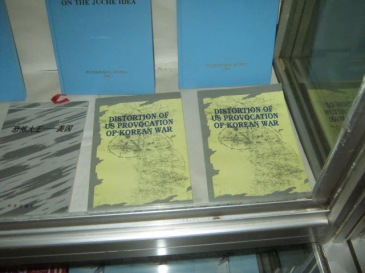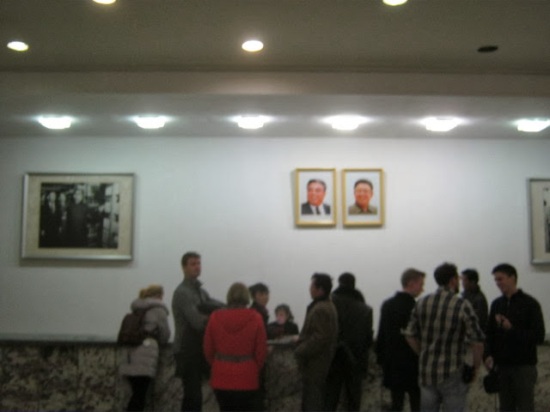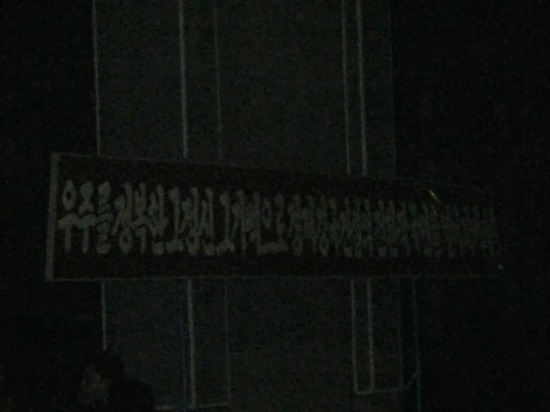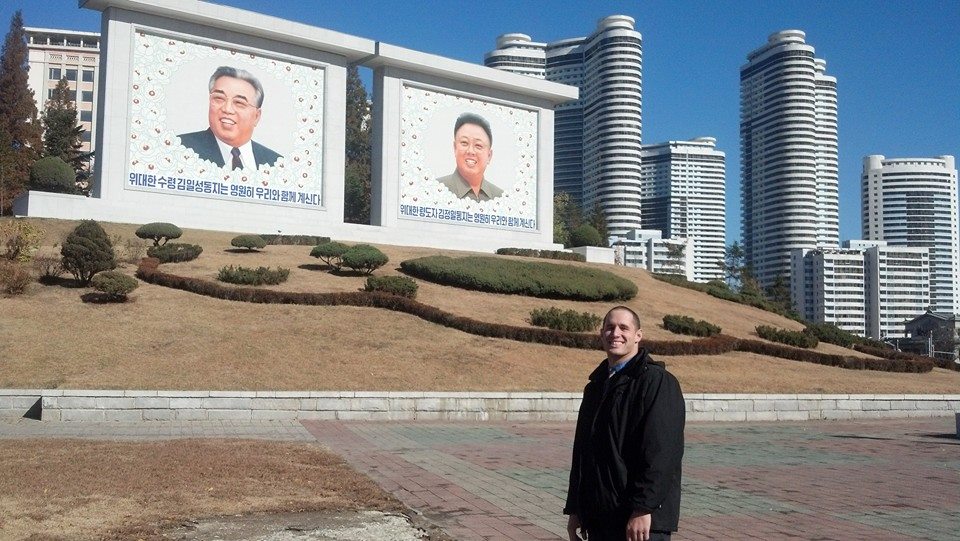For the entire day, our guides kept talking about how we needed to allow a significant time for the Victorious Fatherland Liberation War Museum (Korean War Museum), and when I got there, I finally understood why. There was a very dramatic stone entrance (one side said 1950, the other 9153), and about a half mile down, there was the museum, with a plethora of statues leading up to it. To say the least, it was quite grand. We were met by an English-speaking North Korean soldier, who would be our guide.
The first stop was the area where they proudly displayed all of the US items which they’ve proudly captured (military vehicles, ammunition, etc.) They did concede that not everything was from the US, and that some of it was from affiliated allies, but it is mostly US stuff. Next up was the USS Pueblo, the American battleship which was captured. We walked into it, where we started out by watching an incredibly anti-American “educational” video about the history of the USS Pueblo, and its capture. We then toured the ship, which, save for a few Korean signs, looked to be almost in the same condition as when it was captured – we saw where they ate, where the communications were, where they slept, where they studied, and so on. There were all sorts of documents regarding the capture and surrender. The guide let us know that one of the North Korean soldiers responsible for orchestrating the capture presently works as a guide at the museum. I asked if we were going to get to meet him, but she said that he was not working that day. I then realize, being an American, this is probably for the better. They then showed a significant amount of original documents, mostly consisting of different communications between the US and the DPRK, admissions of mistakes, pictures of the soldiers being humiliated, and so on. At one point, the guide said to me (in broken English), “there is a Pueblo, Colorado, right?” I was initially confused and had her repeat it, and I replied yes. I’m not sure why she wanted to know that.
Aside: I forgot to mention that while I was at the DMZ, the North Korean soldier asked me about my profession. Trying to think of something very vague and easy to understand, I replied “politics” (which was true at the time as I worked in political polling). I got a quizzical look, quickly realized my mistake, and replied, “statistics”, which was much more pleasing to them.
After we finish touring the Pueblo, we walked into the absolutely lavish, enormous museum. They told us we could not take pictures. This was unfortunate, as the museum was undoubtedly one of the highlights of the trip, and words cannot even begin to describe how elaborate it is. Just about everything was made of gold. There was a statue of Kim Il Sung by the entrance which we were asked to bow before.
We were informed that the entire museum would take 2-3 days in order to see all of it, but that we would be on an abbreviated tour. There were a fair amount of North Korean citizens all touring the museum. All of them were wearing muted colors, no bright colors (a consistent trend throughout the trip). Some stared at me. The first room we went to, they played for us a short video entitled “Who started the Korean War?” (answer: America). We then began to tour the museum. Every room and section was very well-organized with tons of assorted artifacts, maps, and other materials, including many written letters to and from Kim Il Sung.
Unfortunately, I am writing this all from memory, and I wish I could remember more of the tour. But there were a few things in particular which did stand out. At one point, demonstrating the tunnels which were dug beneath the border, there was a recreated tunnel that we got to walk through, showing the different little hideouts used for different purposes. We also went into an enormous planetarium-sized room, with a gorgeous painting of the war that stretched 360 degrees around us, and we then slowly spun around the room. They said the painting took over a year to complete. We did however skip the room titled “crimes committed by the US.” One of the final rooms depicted the end of the war, with a recreation of a battlefield with several dead US soldiers, with vultures attacking their bodies, and a recorded loop of a vulture sound in the background. Disturbing, to say the least. The next room was a lengthy hall with a plaque dedicated to every North Korean soldier who fought in the war. Naturally, throughout the tour, the tour guide/soldier was providing all sorts of delightfully anti-American skewed accounts of the Korean war. The tour took several hours, and I was quite relieved when it was all over, as it was very intense, especially for an American. We left the museum, with it now being dark outside, and got on the bus. Several others in the group were impressed with how calm I remained throughout the whole thing.
Final dinner, and final night in the hotel (with bowling and karaoke)
We began driving to the restaurant for dinner, and on our way, a bicyclist tried to cross the street in front of our bus (illegally). Our bus driver honked at him, swerved out of the way, and avoided an accident (it was entirely the bicyclist’s fault). I then saw one of the ubiquitous turquoise-uniformed crossing guards start marching (literally marching) over to him, with a look of death in her eyes. I didn’t see the rest of it, but I sure would have hated to be that guy.
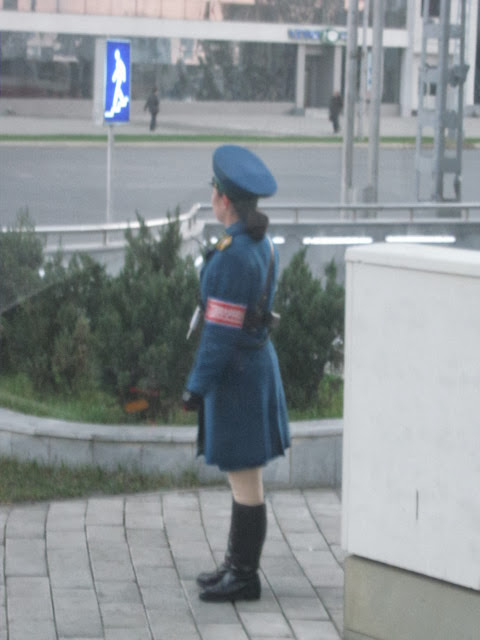
We walked into the restaurant, and I was relieved to see that there are actually other locals eating, for once. On top of that, our guides were going to eat with us too, which was definitely a good sign. There were several tables reserved for us, each with beer, water, and several plates of raw duck meat, with a do-it-yourself grill in the middle. At this point, I started to get really excited. This turned out to be undoubtedly the best meal of the trip, as it was your standard Korean barbecue experience, but only using high-quality duck meat. It was so delicious. I wish more Korean places did this. They also brought out some dumpling soup, some rice, and some kimchi, all of which were delicious. However, as we looked over to the table where our guides are sitting, we noticed that they are eating nangmyeon (cold noodles), a Pyongyang specialty (arguably Pyongyang’s signature dish). We were informed that due to a tourist getting sick previously from eating this, they do not serve it to tourists any more. Regardless, it was still a delicious meal overall. To celebrate the trip, we ended up ordering several extra bottles of soju. Fun times.
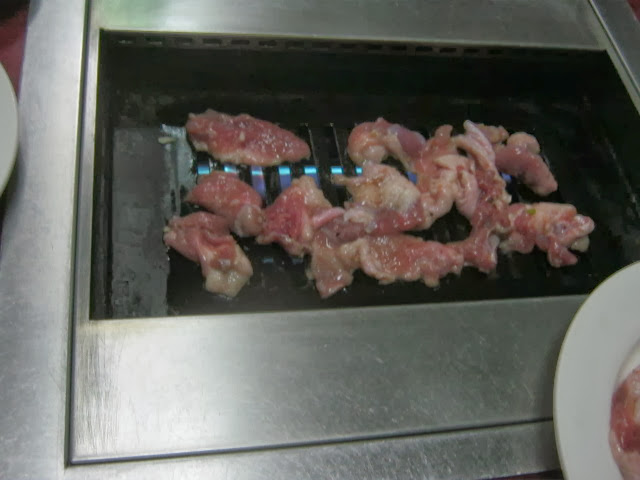
After the meal, we were informed that our cameraman was going to show us the video that he has produced of our trip up to the end of the first full day, so that we could decide if wanted to buy it or not. We sit down in another room of the restaurant and watch it. There were some cheesy intro graphics, but overall, I was pretty impressed with the quality of the video; He definitely knew how to zoom, pan, etc. However, the actual picture quality showed that it clearly was not shot on a top-rate videocamera. Some people in our group decided to buy it, but at $40 USD, I passed.
It was the birthday of one of the people in our group (I can’t say North Korea is where I would have wanted to spend my birthday, but each to their own), so after dinner, we planned to go to the “nightclub” in Pyongyang (frequented by diplomats), but it was closed. That’s life in North Korea though; never know when something will be open.
We headed back to the hotel, and discussed procedures for the following morning (some people were staying longer, some people were taking the train out, etc). Breakfast the next day would be at 6:30am, and we would leave at 7am for the airport. As it was the last night, we decided to all head down and take advantage of the miscellaneous facilities downstairs.
We start out at the bowling alley. Just like in America, I asked for the biggest size shoe they had (but unlike America, they didn’t have anything that I could remotely fit into, so they let me keep my current shoes on). The bowling alley initially didn’t seem too different from your typical bowling alley; 4 lanes, automated scoring with cheesy animations when we got a strike, spare, etc. We formed a few groups; our guides and cameraman also joined. Though the cameraman didn’t speak English, he still understood basic cues like pointing to him when it was his turn, etc.) While initially things looked normal, there was some trouble with the pins being reset, and we saw a guy emerge from the back waving his hands shouting something in Korean. I had a feeling that he was responsible for manually resetting all the pins every time. I had one of my better games in a while, with several strikes. Though it was not good enough that I’d return to the DPRK to replicate my bowling luck 🙂
The next stop is karaoke. We entered a pretty small, dark room with lots of tacky Christmas-y lights (but not actual Christmas lights of course; there’s no Christianity allowed). There were a couple other people there, plus a bartender, and the person in charge of the karaoke, which consisted of a woman with her laptop with an iTunes-like program open, just clicking the songs that people select. The songbook only had titles, no artists. There were several languages available, including English, Chinese, Korean, and maybe a few others. Most of the songs I either didn’t recognize, or weren’t good karaoke songs. I then saw “Don’t Stop Believing.” Figuring this was pretty much the universal karaoke song, and one that everyone would know, I chose this one. However when it’s my turn, she chose a song that’s slightly ahead in the alphabet instead (“Don’t” something else).I corrected her, and she still came up with a different “Don’t” song. Finally, we got to “Don’t Stop Believing.” except it’s a DIFFERENT “Don’t Stop Believing” that I’ve never heard before. I decided to just make up a melody based on the lyrics on the screen.
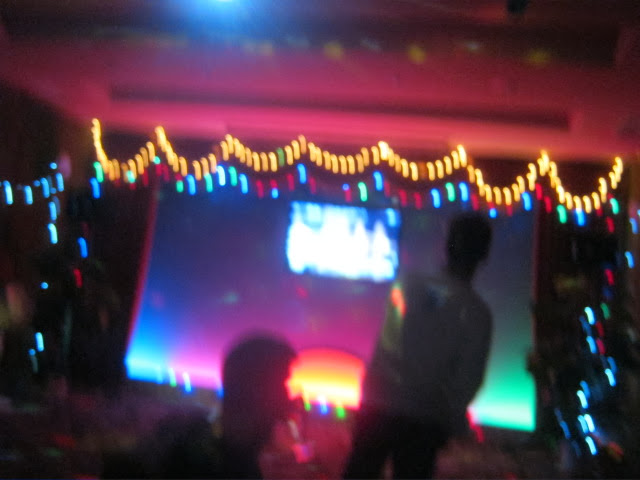
This kind of turned me off from choosing other songs, but I stuck around to hear the others sing anyway. Finally, I decided to give it another try, and picked “Hey Jude”, based on its popularity earlier when I played it on piano. However, she chose “Hey Joe” by Jimi Hendrix. As I actually knew this song, I didn’t bother to correct her, and went through with it.
We finally left karaoke, and then went up to finish off the night at the revolving restaurant on the top floor. Except it’s not revolving. In addition to that, the interior is extremely poorly designed, so that the glare from the lights inside shone all over the windows, obscuring what would have been a beautiful (albeit mostly dark) view of Pyongyang at night. I decided to head to bed instead of staying up. We were in the same hotel as before, and I was assigned the same room. Weirdly enough, as if they knew I’d be coming back, there was a Canadian 50-cent piece that I had accidentally left there the first night, and it was still there.
I got up at 6am to shower; again, with no hot water. I headed down at 6:25am for breakfast. Our elevator stopped on the 16th floor, and in walked my tour guide Rim. I’m a little surprised to see him, as I had assumed that despite what they said, that they didn’t actually stay in the hotels, and likely instead stayed in Pyongyang. He asks me how I slept; I told him “fine.”
I headed into the room for breakfast. Breakfast was mostly similar to before, though no fancy underripe tomatoes. There was some good boiled cabbage, an omelette, crepe-like sweet things, a yogurt drink, and this time I smartly ordered tea. I only ate with the four Finnish people in our group, as they were the only ones flying out at the same time as me. At breakfast, we pooled our tips together for the tour guides to give to them later.
We then got onto the bus to head to the airport. At this point, we then get our passports and tourist visas back (they had collected them on the first night, with no explanation). Before leaving, I gave our cameraman a pack of cigarettes as a tip (as he was not coming with us to the airport). He and our bus driver (especially the latter) smoked quite a bit throughout the trip. Neither of our tour guides did though (somewhat unusual for a male, not so much for a female). As we drove through Pyongyang at 7:15 am, there are people EVERYWHERE. And not just in one part of the city. I asked our tour guide if they’re going to work, and she said yes. But I couldn’t imagine everyone went to work this early. As usual, everyone is wearing brown, black, or grey (blending in with the scenery, sadly), except for the occasional little girl wearing bright pink or red.
Aside: I forgot to mention that our guide was careful to explain that under their wonderful socialist housing system, the government owned all housing, and everyone was given new housing every five years, with first priority to government and military. We tried to ask for more specifics, but had no luck.
Though it was hard to know for sure given the lack of street signs, I’m pretty sure we passed the area where they pointed out to us a gas station the day before, but there was no gas station. Eventually, we got to the airport. I give the bus driver a pack of cigarettes as a tip. It looks a little dim inside the airport, but I figured that was just Pyongyang. However, we couldn’t go in. After the guides talked to the security officers, they informed us that the power has been “cut” (I’m also relatively certain that this is a result of their lack of English knowledge and that they meant to say the power had gone out, rather than had been deliberately cut, but who knows). After waiting around for about 20 minutes, it came back on. We then began the goodbye process. We gave the guides their cash tips, and I also gave them each a chocolate bar from San Francisco. I shook hands with Rim (male guide), and I went to give Oh a hug, which she totally was not ready for. I’m not even sure if she even understood what was going on, acting as if she’d never received a hug before. Whoops; cultural faux pas. Should have just shaken her hand too. I told them both to let me know if they’re ever in America so that I could show them around, but I knew that there was very little chance of this happening.
I made it through the metal detector. First step cleared. Phew. Next step is to get our boarding passes. I presented a document that they’d given us earlier for the entire group. They then gave us our boarding passes, this time printed on Air Koryo paper. There was a picture of the Juche Tower on back. The last stop was customs. I made it through, and they collected my tourist visa. Phew. i wouldn’t have to stay in North Korea. There was a small duty-free store, which seems to sell Coca-Cola (surprising, as i thought the DPRK was one of the few countries where coke still didn’t exist; perhaps it was fake). The waiting area was otherwise non-existent. As usual, our flight was late. Finally, they signaled us to go out. We walked out to a shuttle bus which was then going to take us to our plane (not sure why the plane couldn’t come closer to the gate; there certainly wasn’t anything else going on). It was freezing cold outside, and there was no heat on the bus. The bus driver was reading the local propaganda newspaper while waiting for the bus to load. After waiting for everyone to get on, we then headed over to the plane.
Similar to before, there was a display rack set out with all of the local newspapers, and I grabbed a few for the flight. Taking off was mostly similar to before; same videos, etc. This time, the two-hour flight back wasn’t as exciting, as the novelty had somewhat worn off, and I did’t have anything to listen to. The same crappy food and good beer is offered; this time I did’t even eat any of the crappy burger. My ordering of a beer (at 9am) raised some eyebrows, but I figured this is probably the last time I’ll ever get to have this beer. We landed in Beijing two hours later, safely. I switched my phone away from airplane mode, and text messages started to come in. I then connected to the airport wireless network, and started to receive personal and work e-mails (though of course no Facebook notifications). I took a deep breath and smiled. Ah, China never felt so free.

